For 3 weeks in October 2019, I had the chance to travel to various parts of Tunisia. Here are a few thoughts on a short trip — touching on transport, lodging, attractions, and stuff I noticed along the way.
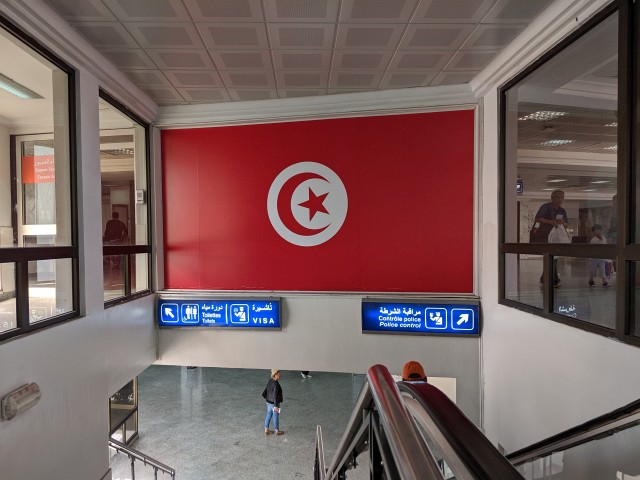
It was a pure vacation, insofar as I didn’t use the laptop that I’d brought with me at all. I thought I might have a chance to talk to some of the local makers and makerspaces, but my mind wasn’t on it at the time. Someday, perhaps, I’ll have a chance to go back and do that.
It’s a beautiful country, but it feels like there’s a lot of lost opportunity here. It could be so much more.
Getting In
For most people, the main entry point is the capital city of Tunis, situated at the northern end of the country. The other major international airports are located in Monastir, which also serves the city of Sousse; and Djerba airport, which serves its eponymous resort island.
For me, there was a direct flight from Frankfurt airport, but it seemed like the majority of flights were coming in from France, Italy, Russia, and countries in the Middle East.
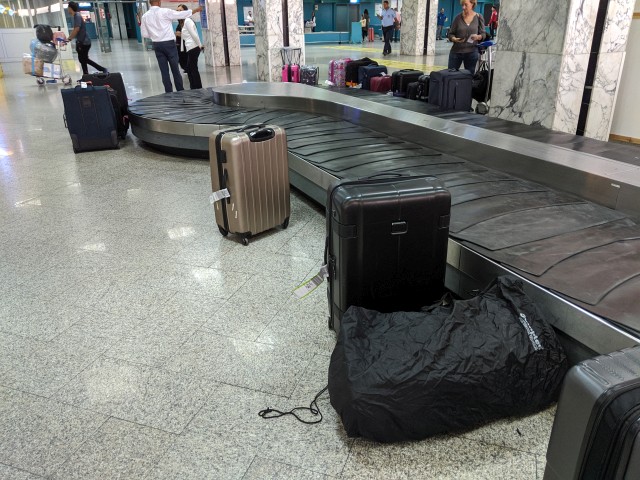
When landing at Tunis Carthage International Airport, before even leaving the baggage claim, there was an opportunity to pick up a free SIM card from Orange with 100 MB of mobile data.
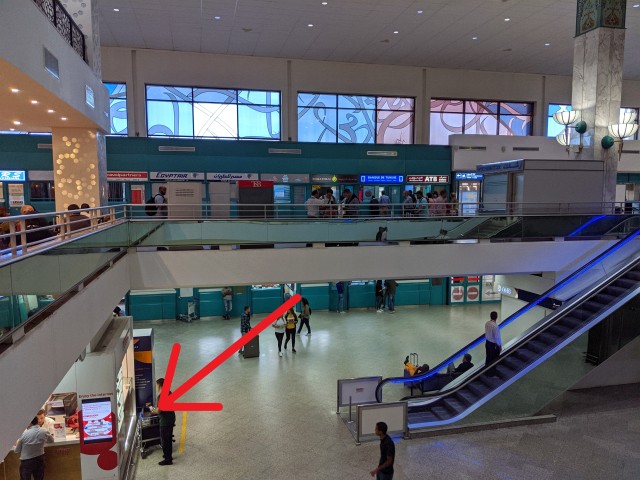
In the main terminal lobby, there were also kiosks from Orange, Tunisie Telecom, and ooredoo where a traveler could buy or top up a mobile plan.
At the time, the prices were ~ 5 DT (dinars) per 1 GB of prepaid data.
Money
The decimalization system takes some getting used to, as prices are denominated out to the thousandths. You will see prices written as 1.350 DT, which is spoken as one dinar, three hundred fifty mills.
The thousandths position is almost always 0, rendering it essentially irrelevant.
That doesn’t sound too bad in writing, but it takes some practice with on-the-fly currency rate conversions to know the value of what you’re paying.
In late 2019, the exchange rate hovered around 2.900 - 3.100 dinars per Euro, depending on the bank commission.
After converting a few euros into dinars, I was ready to leave the airport.
Security
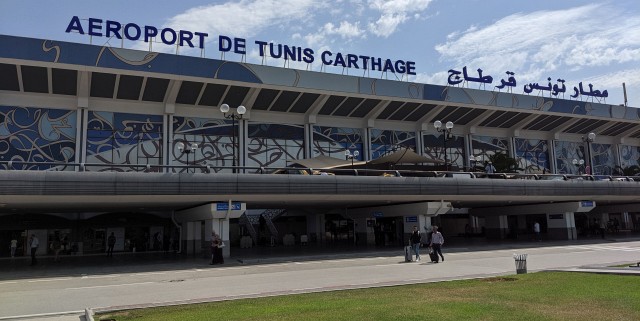
One of the first things I try to notice in a new place is the sense of security it radiates, whether it has a low-trust / high-security or high-trust / low-security posture. This tells me how closely I need to guard my wallet.
All of the entrances to Tunis airport have bag scanners and metal detectors on the way in to the main terminal lobby. These are the visible long-term effects of two terrorist attacks in 2015 (one in Tunis, one in Sousse). Police officers stationed around the airport grounds were armed, often with at least one member of each patrol group carrying a Steyr AUG assault rifle. I wondered at what point they had chosen that as their service weapon and at what point the Austrians had come in and sold them.
I started to get a sense of what the country was going to be like.
High security it is, then.
Getting Around
The other thing I was looking for on arrival was: How good is the signage and what options are there to get in and out of here? And where the hell is the bus into the city?
After much digging online at home, I’d read that there was a bus line from the airport into the city, which would then let me switch to a light rail line. But as far as signage went and particularly route information, well, I couldn’t see it.
The Airport Taxi
It’s a subset of taxis as a whole, but demands a special section of its own.
The taxi drivers at Tunis Carthage airport have a nice little cartel going and will charge you 3 - 4 times the real rate to get into the city. This happens to locals too, if they can’t get a pickup, a friend told me. It doesn’t matter which taxi you end up in.
Since all of the taxi drivers are in on the scheme, they have a lock on transportation from the airport, and they can do as they please.
So the taxi drivers all try to get you to ride with them, the hustle is strong and everyone is calling you over to get in their car. And it just blatantly smells like a rip-off.
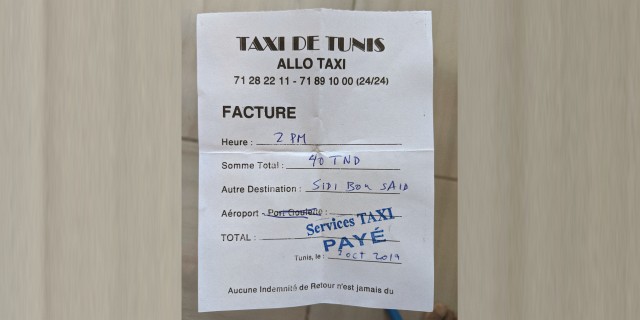
In any case, I ended up in a taxi with a "broken meter" and a gesticulating driver who charged me a "fixed price" astronomical 13 EUR to get where I needed to go. Sarcasm aside, the money didn’t matter as much as the weird back and forth dance people do when you know they’re ripping you off, and essentially they know you know.
It’s not the greatest introduction to a country, but then, I’ve been ripped off by taxis in Germany as well, knowing full well, as an avid cyclist, that they were taking me the longest way possible through my own city.
My French is terrible and my Arabic is even worse, so the fee was justified for local expertise. And we were certainly making a beeline for my accommodation.
Seatbelts are optional.
Regular Taxis
As I would later learn, regular taxi rates in Tunisia are stunningly low, depending where you are and if you can get the driver to use a meter.
A thirty minute, 10 km taxi ride cost ~ 4 EUR at the time of writing, but I wouldn’t learn this and the true costs of all the other forms of transport until much later.
Many drivers will try to negotiate a price with you verbally. Do not do this. You will get a bad price. By the end of the trip, I had already developed a shockingly thick skin to their entreaties and knew when a price sounded wrong.
Unless you are truly stuck, you can definitely say no.
Ridesharing
There was one taxi-hailing app in the city, Bolt, which I didn’t install on my phone before entering the country. The app actually did a good job of price discovery and keeping naive foreigners from getting ripped off.
Rides hailed through the app were in line with the regular taxi rate.
But… even this is a challenge to use at the airport, where no driver for Bolt would dare to pick people up at the Arrivals section! The taxi driver cartel instills fear in these strikebreakers.
Tunis Metro
For the main line running from Tunis Maritime to Sidi Bou Saïd and La Marsa, the cost is distance-dependent, but was something like 40 Euro-cents to travel the entire length. It’s faster to take a taxi, at 10x the cost. Your choice.
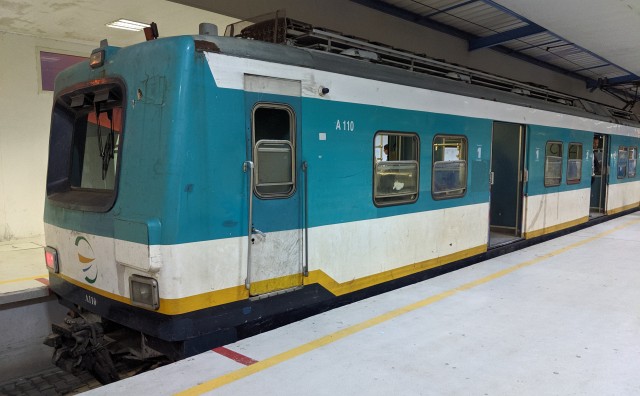
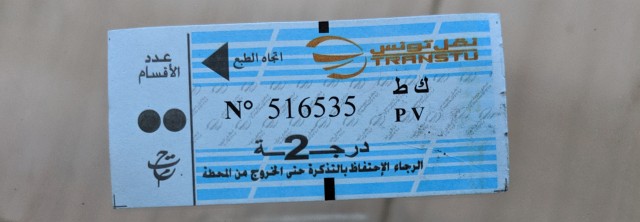
Long-Distance Trains
The trains never run on time. Do not plan connections accordingly.
Also, the Société Nationale des Chemins de Fer Tunisiens website has one of the most unholy-frustrating route planners I have ever seen. You will waste hours in there only to learn that, really, there is one timetable for everything running north-to-south, and one timetable for the return, and that adding a website on top of an old-fashioned paper timetable is pointless.
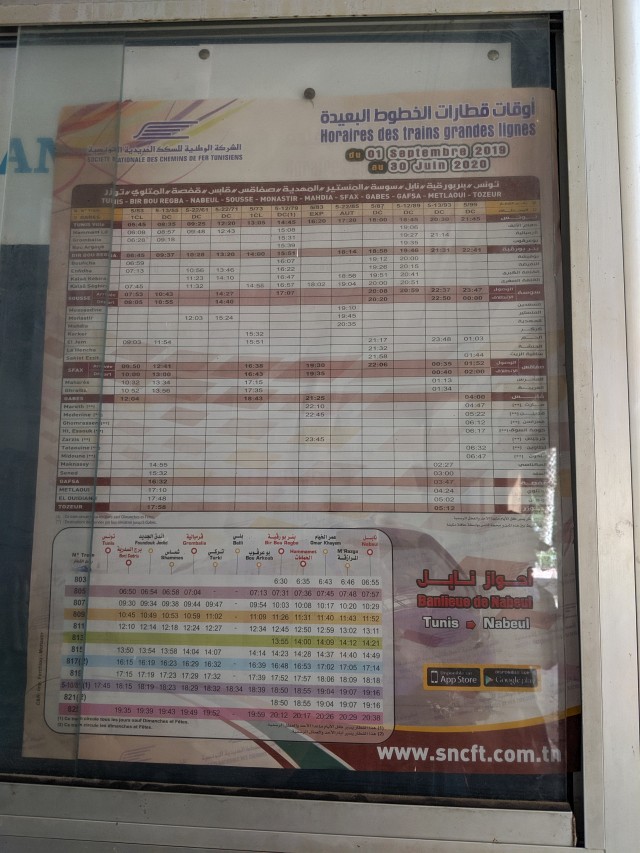
The rolling stock in Tunisia is pretty old and the rails are in need of re-grading. The average travel speed seemed to be less than 120 km/h, as the train would regularly slow down and speed up depending on the condition of the tracks.
Example: Hammamet (Bir Bou Regba) → Sousse is a total of ~ 92 km using a national road.
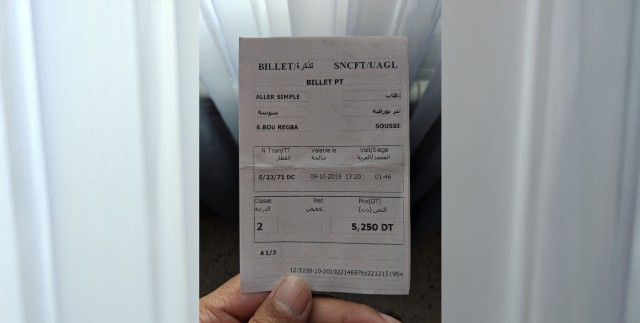
By car: Estimated travel time would be about an hour and twenty minutes.
By train: Arrived at the station around 1:15 pm, train was delayed, boarded 2:47 pm, arrived at Sousse 4:22 pm. So… 3 hour total transit time and most of the useful part of the day wasted.
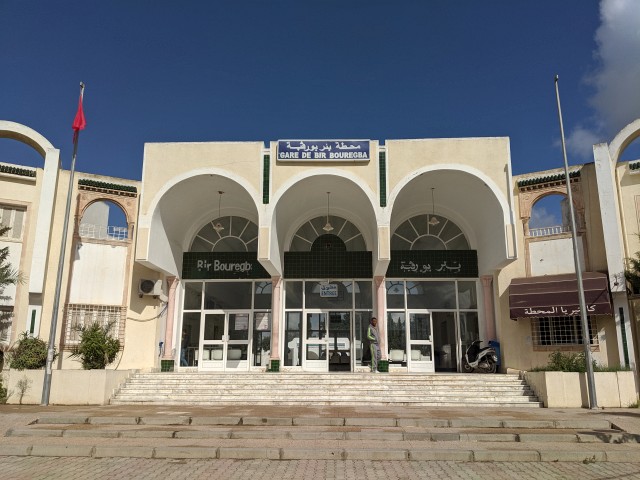
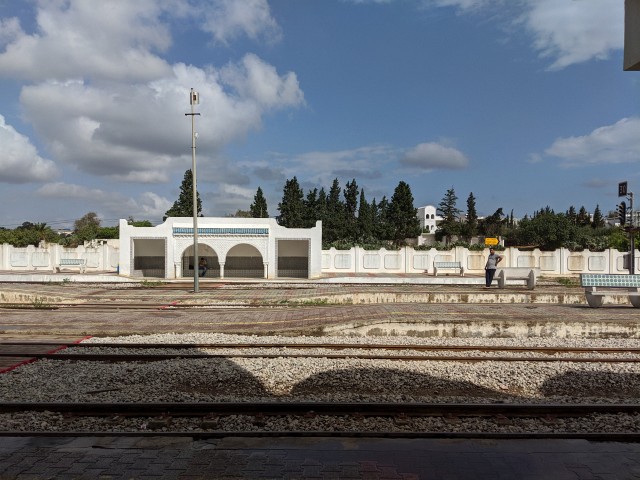
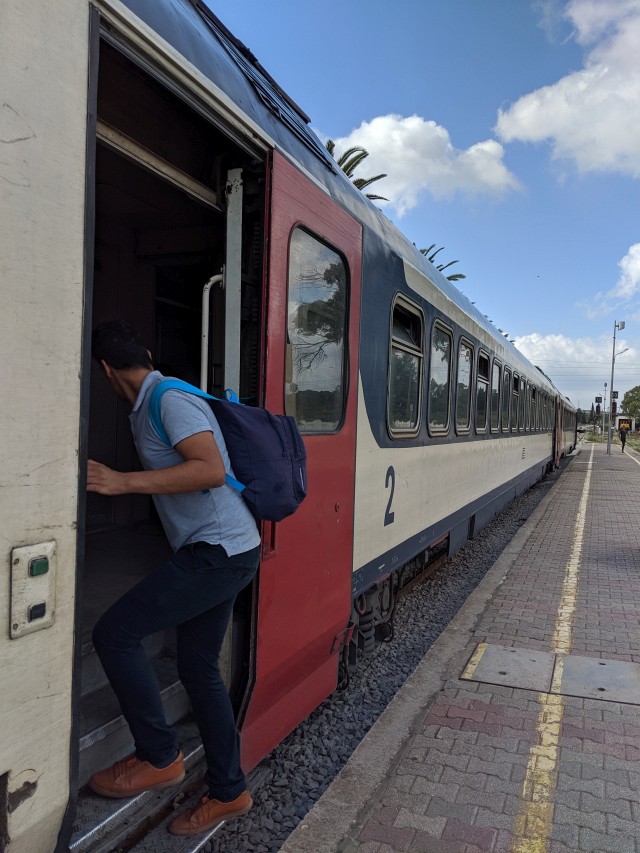
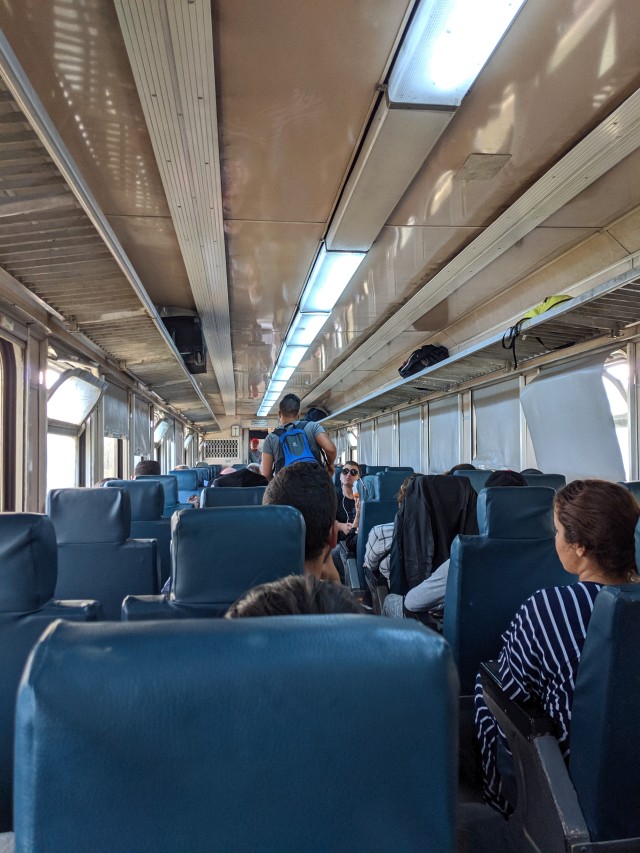
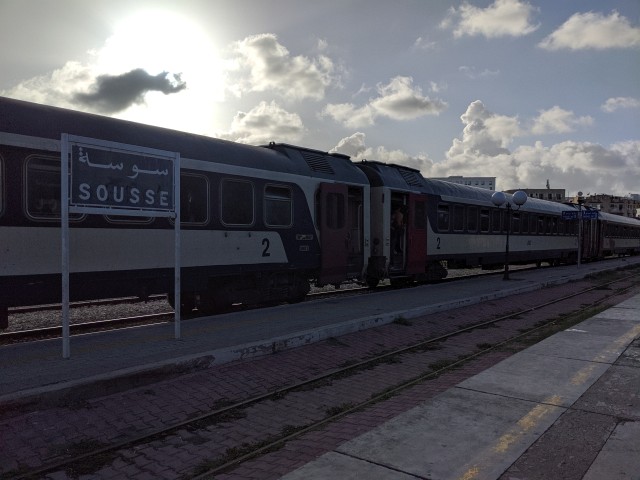
For all the complaining that Germans do about the Deutsche Bahn, well, they really shouldn’t. Oh no, they shouldn’t. And the fact that there are regular regional trains at all still puts this ahead of most metropolitan areas in the United States.
The prices are infinitely reasonable, however.
Example: Sfax → Tozeur for 13.900 DT, i.e. cross half the country for ~ 4.50 EUR.
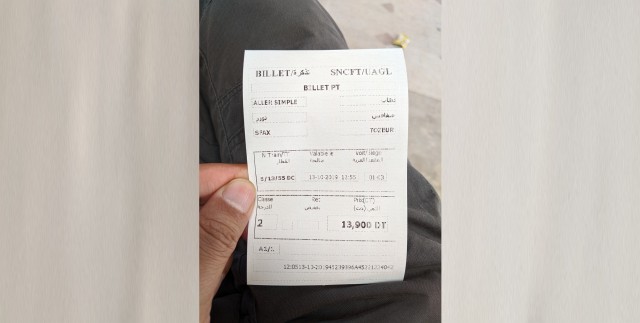
Buses
For the one ride I did take, the schedule was only a suggestion.
-
Be prepared to be dropped off at a crossroads at the outskirts of a city. You’re there enough.
-
You can usually get the ticket on the bus.
-
You’ll usually be able to get a local taxi at the crossroads.
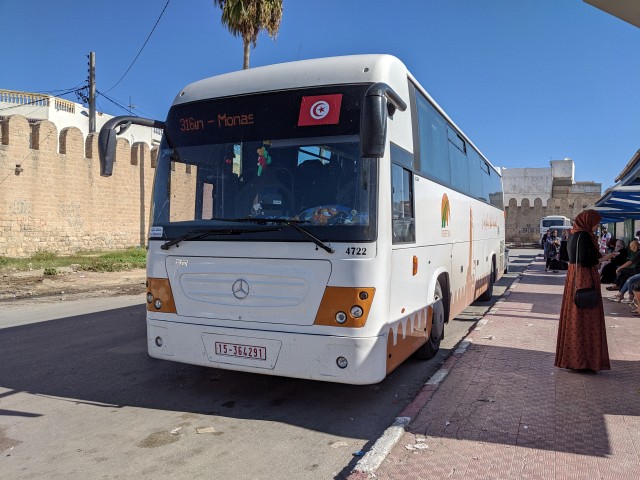
Louage
It was only after spending a bit longer in Tunisia that I discovered the proper way to get around.
Louage = shared taxi vans = you and 6 other people traveling point to point. The vans have trunk space for luggage, and for the solo or group backpacker, this is the way to do it.
Prices are very good, too.
Example: Monastir → Sfax for 9.900 DT (~ 3.50 EUR)
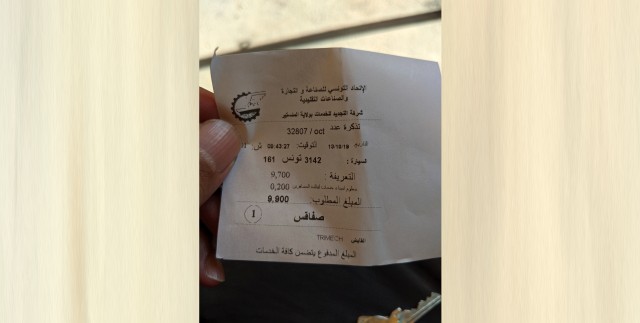
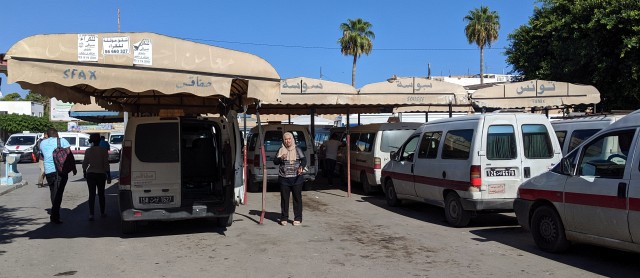
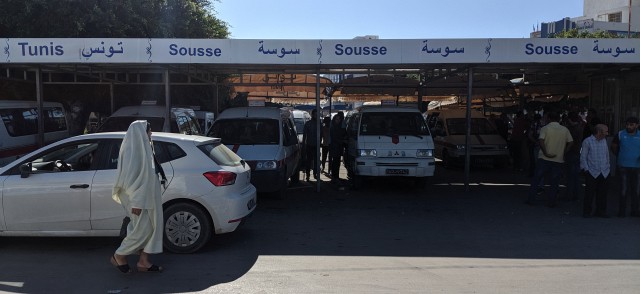
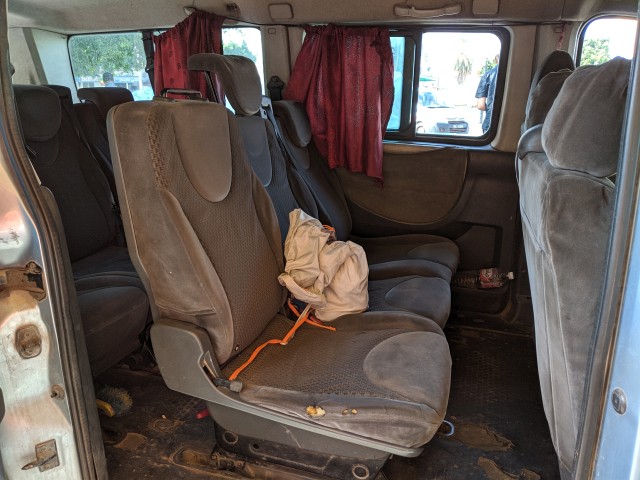
I can wholeheartedly recommend this method of getting around, and it is simple, with a few caveats.
-
Get there early. More people will want to depart before the heat of day sets in.
-
The van leaves when all of the seats are filled. If you’re lucky, you’ll be the last one to join a departure; if not, you’ll wait a while, but not usually too long.
-
This is one place where the calling and hustling can be helpful. Drivers will point you in the right direction to get the ticket you need and the signage is good. Ticket offices on site will sell you a fixed fare between cities. The louage service is somewhat regulated, you do not have to haggle over price.
-
You might have to make more than one hop to get to your destination. Certain routes which might seem sensible, might not exist. However, the louage operators will know where you need to go to make the connection.
Example: Kairouan to El Jem. Didn’t exist, I had to go through Sousse first. ¯\_(ツ)_/¯
With transport covered, let’s talk about where you can go.
Places To Go
Tunis: Sidi Bou Saïd
There were a lot of hotel options closer to the city center, but my money was on a rental apartment in Sidi Bou Saïd, one of the nicer neighborhoods in the city and within the vicinity of the presidential palace. It is one of the main tourist areas in the city.
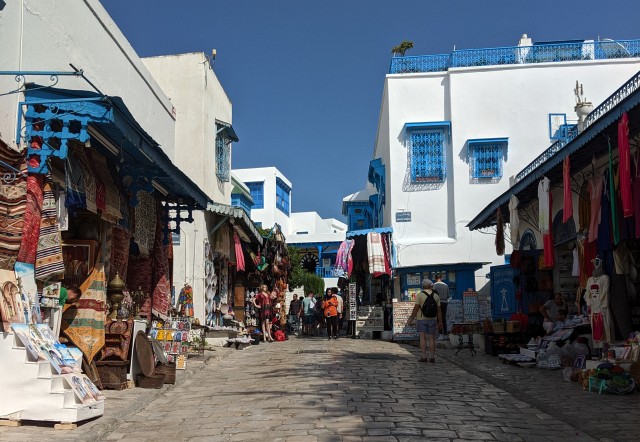
The main street leading through Sidi Bou Saïd ascends to a splendid view over the harbor and the Gulf of Tunis.
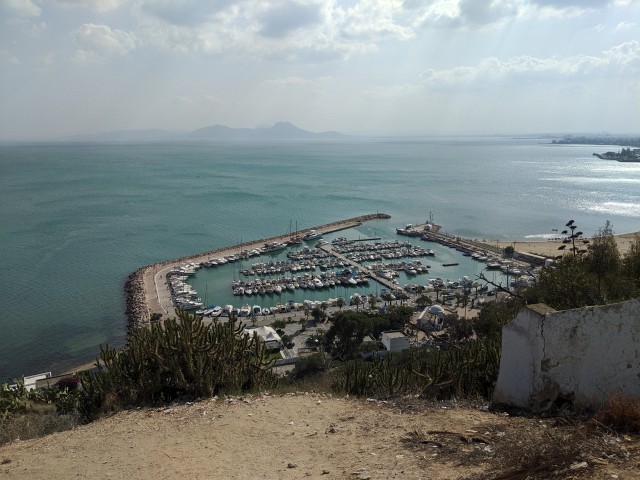
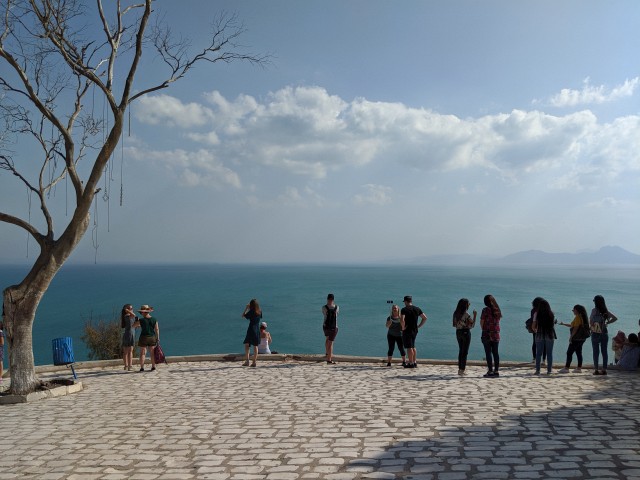
The road north out of Sidi Bou Saïd follows a short stretch of coast before leading to the harbor and beach.
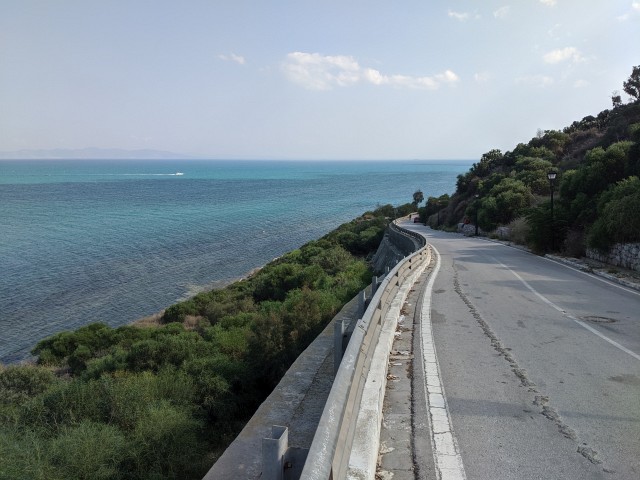
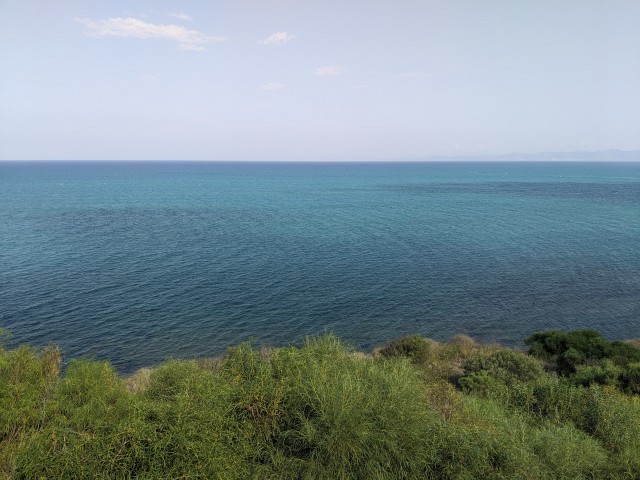
Sadly, walking further along the coast led to the skeleton of a large beachfront hotel complex, a decade into construction.
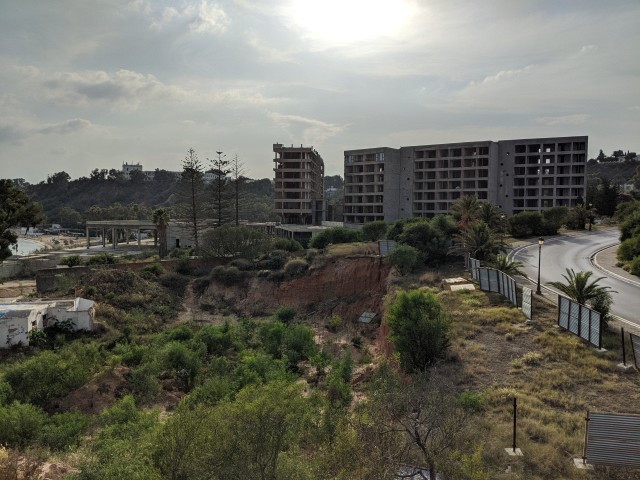
Of interest were the top-floor squatters, who seemed to have a pretty nice setup.
Checking the incept dates on the construction signs near the site: 9 October 2009 and 24 May 2014 (with a 22 month work estimate on the latter).
Less than a year later, on the 18th of March, 2015, Tunis would experience a terrorist attack on the Bardo National Museum and see a second attack several months later on the beaches at Sousse, which would profoundly negatively affect tourism there to this day.
Here’s the code and data used to generate this plot.
That being said, there wasn’t a moment when I felt uncomfortable or unsafe traveling in Tunisia.
Tunis: La Marsa
Nicer, even, than Sidi Bou Saïd, is La Marsa.
It’s probably the wealthiest part of Tunis, with large modern villas, and a beachfront that was warm even in October.
After a day of wandering around on my own, my friends arrived and we moved into our temporary beach house.
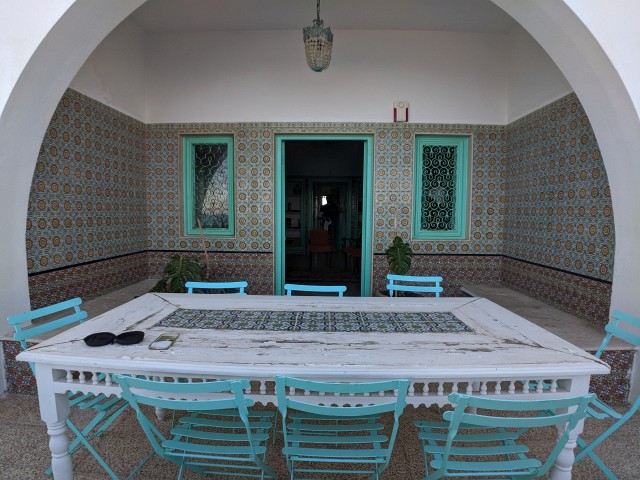
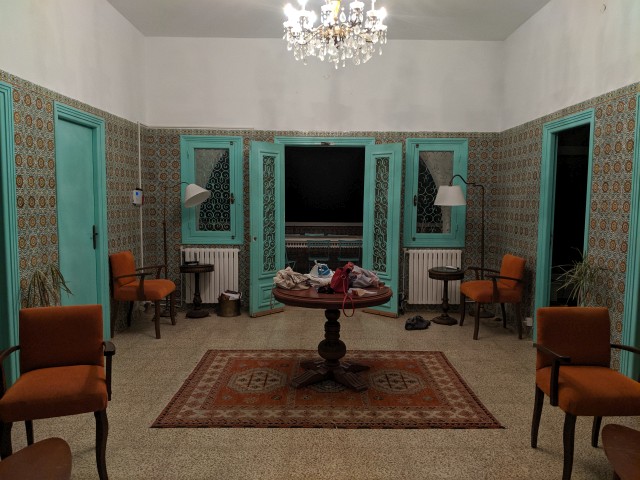
With this view.
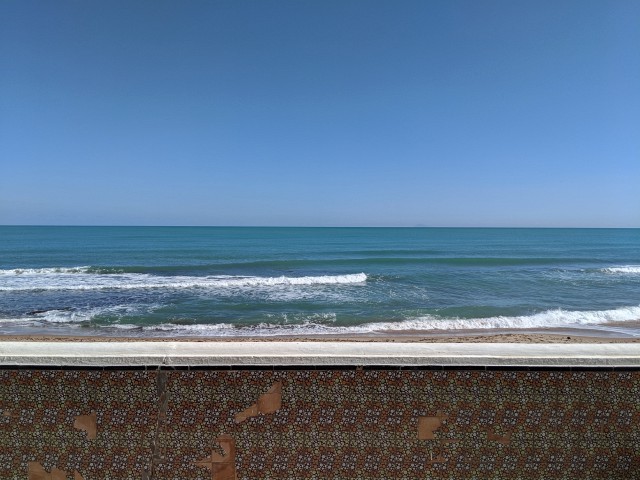
4 rooms for 5 people, at a per-person cost of about what you’d pay for a bunk in most Western European hostels. Yes, please.
Tunis: Downtown
Downtown Tunis is the center of commerce and government. Plenty of people going about their daily work, here.
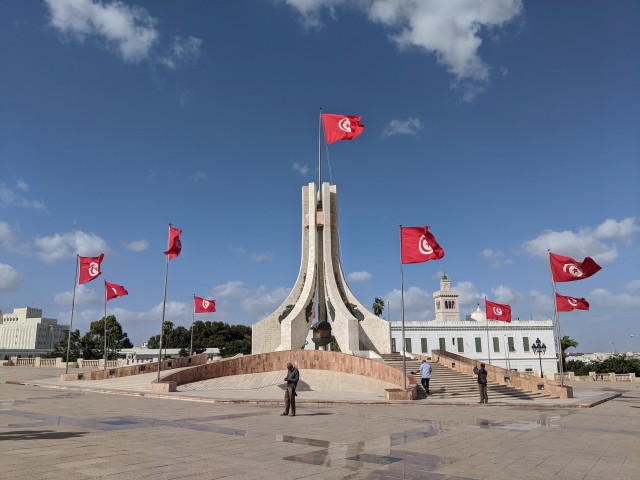
There’s also the old Medina, a warren of narrow winding streets filled with small shops selling goods. It’s worth a visit, if you’re looking for souvenirs, not so great if you suffer from claustrophobia or agoraphobia.
Hammamet
Not much to see here.
Sousse
An overdeveloped resort town with lasting scars from the terrorist attack in 2015. Large, built-up, but empty hotels line part of the waterfront.
The remaining hotels which are open have securitized private beaches, which segment the beachfront.
Sousse does, however, have a Hard Rock Cafe, which is good if you’re celebrating someone’s birthday, but you’ll find yourself in there with all of the other westerners.
Monastir
Monastir is the sleepy beach-town cousin to Sousse. It’s quieter, smaller, and entirely more enjoyable.
Probably one of my favorite places in Tunisia. It doesn’t feel dreadful, as Sousse does, and it’s also host to one of the best universities in the country.
Two things are worth visiting here.
The Ribat
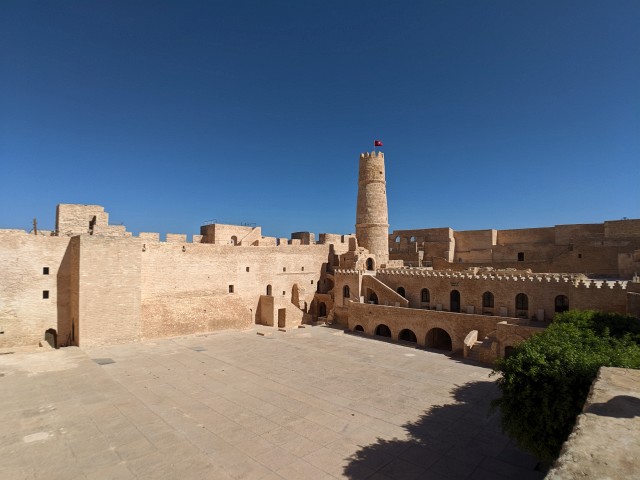
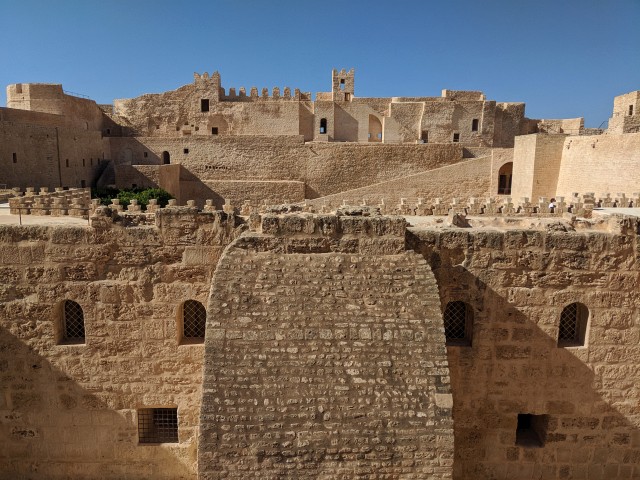
A view from the top.
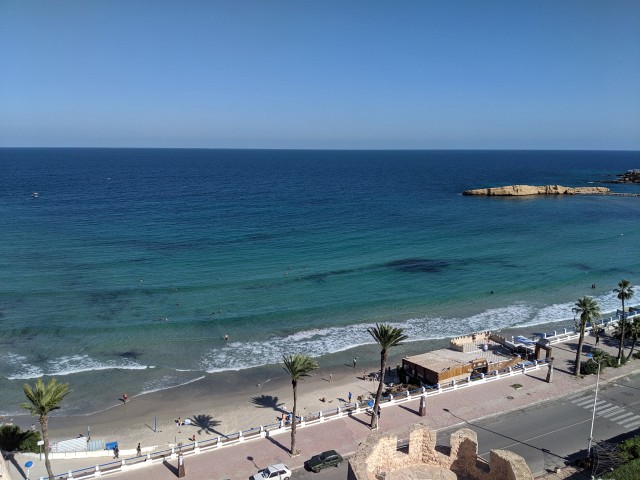
The Mausoleum of Habib Bourguiba
Founder of the Republic of Tunisia, he is still revered today, and what I managed to read about him left me impressed.
In particular, his support for women’s rights, enfranchisement, and education at crucial moments in the country’s history after France’s withdrawal paved the way for what is one of the most secular societies in the Middle East and North Africa.
It may be no accident that Tunisia is the only survivor of the Arab Spring that managed to transition to multiparty democracy. In fact, while I was there, the country celebrated its first transfer of power through democractic election since the Tunisian Revolution in 2011.
The television carried video of proud citizens celebrating along the Avenue Habib Bourguiba in Tunis on the evening of the final election results, and for quite some time that evening you could hear people honking the horns on their cars.
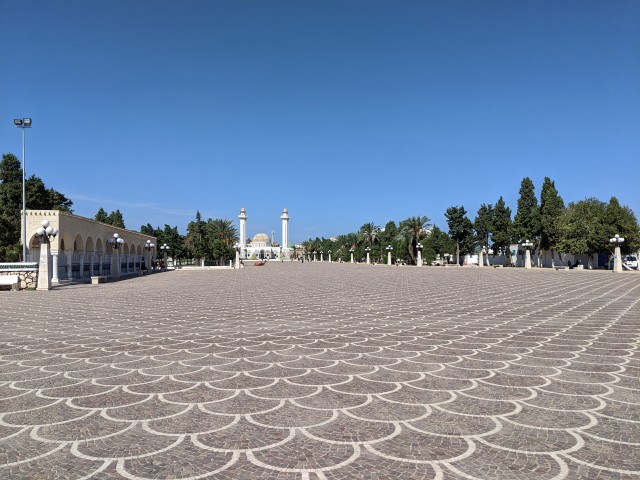
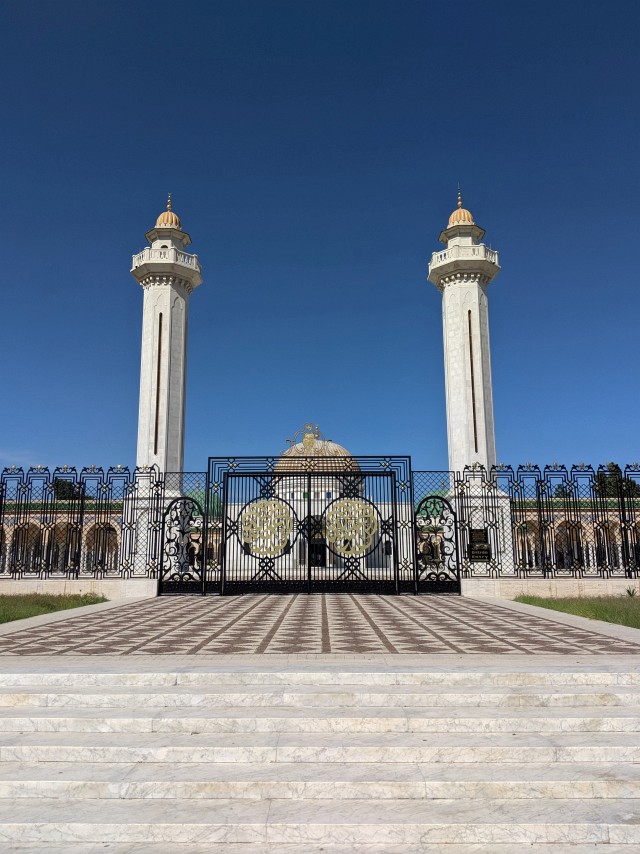
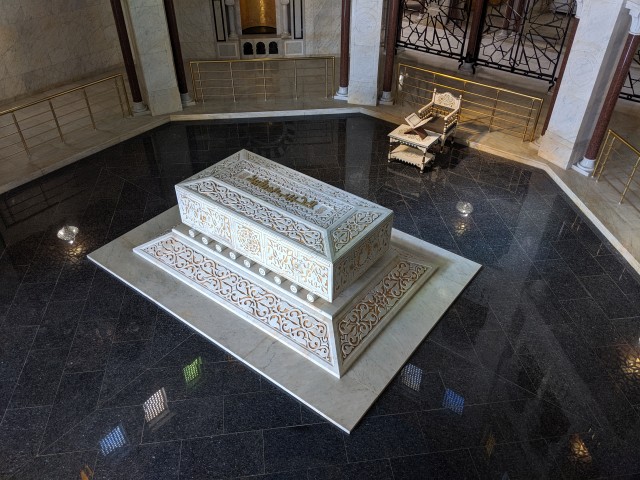
Sfax
Avoid Sfax, it feels terrible there. The first thing that happened when I arrived from Monastir was to get stuck in a traffic jam. So I immediately left on the train to Tozeur.
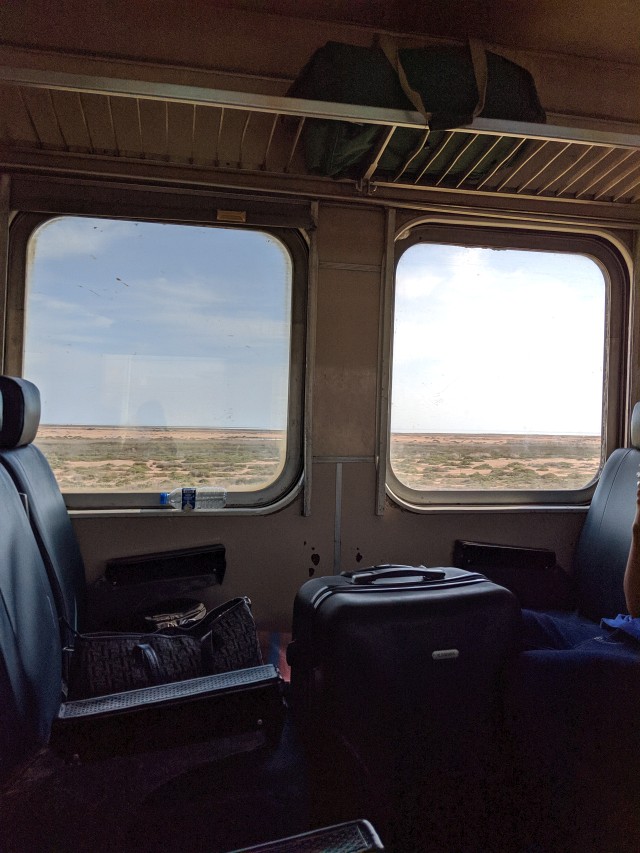
When I told my friend that I did this, she just laughed and confirmed that it was the smart thing to do.
Tozeur
I love Tozeur, but I am afraid it will not last much longer. Located at the northern fringes of the Sahara desert, Tozeur primarily exists to produce dates, the best of which are likely packaged and exported.
To do this, the city pumps up groundwater at such a rate that it has over 1.3 negative meters of rainfall per year. In other words, all other things equal, the water table is dropping by over a meter every year.

The water coming up from these aquifers is crystal clear, you could drink this stuff without filtration, and you can see the pumps and pipework all over the place. I’m not sure how many acre-feet of water are left underground, but if you’re pumping out 10 years' worth of water every year, these finite supplies will not last long.
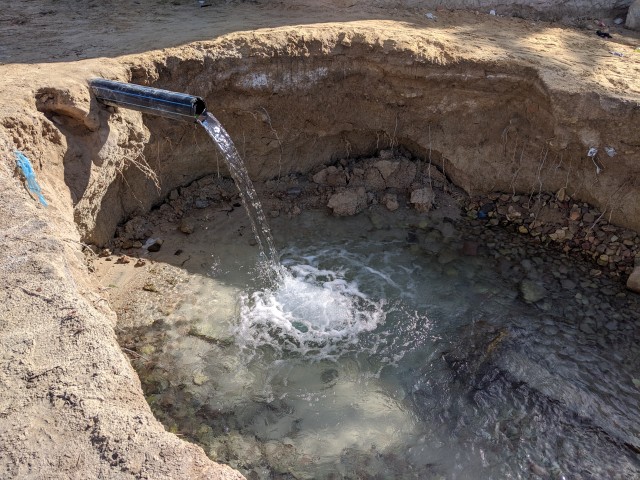
The productive palmeries (palm plantations) stretch out for kilometers from the south of the city, approaching the dried salt lake known as Chott el Djerid.
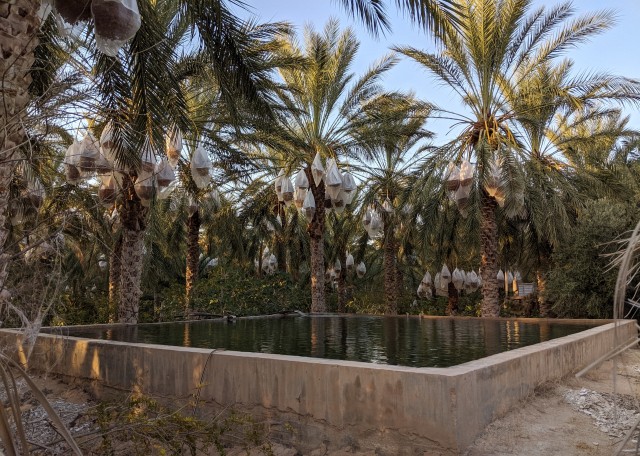
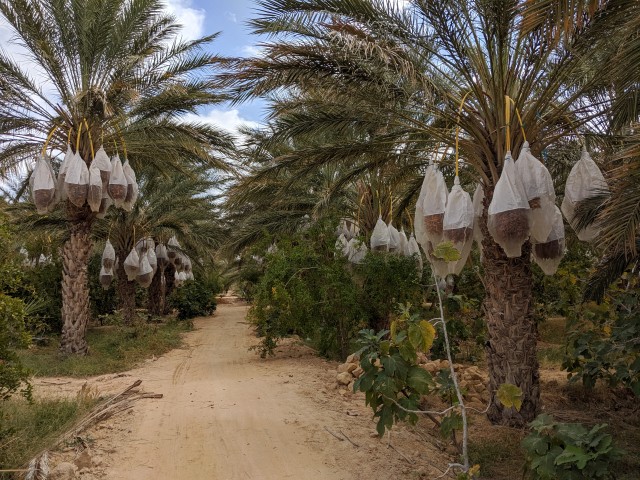
The problem is that the sand itself is salty, and as you draw nearer to the Chott, the more you see crystals of salt forming at the surface, most likely driven by dew-forming + evaporative processes. The intensity of the desert agriculture on display is simply not sustainable.
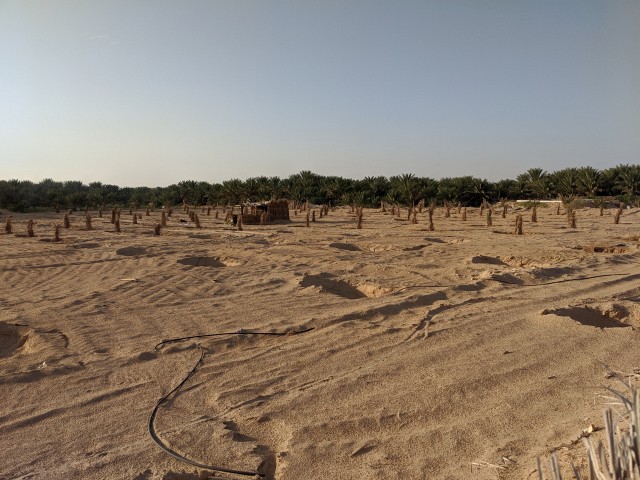
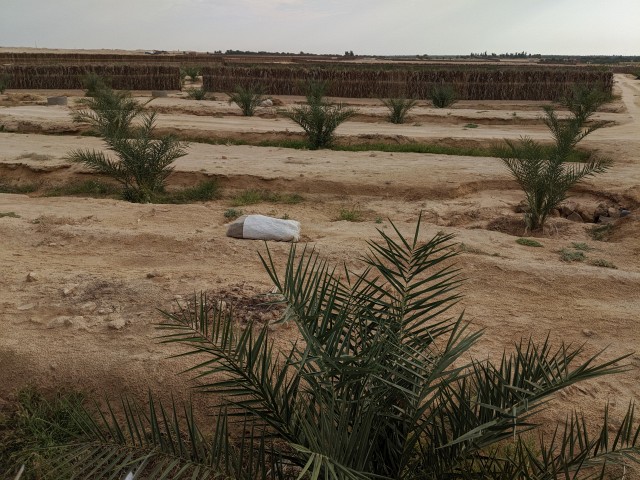

Walking out into the desert was more interesting than many of the most cosmopolitan cities I’ve ever been in.
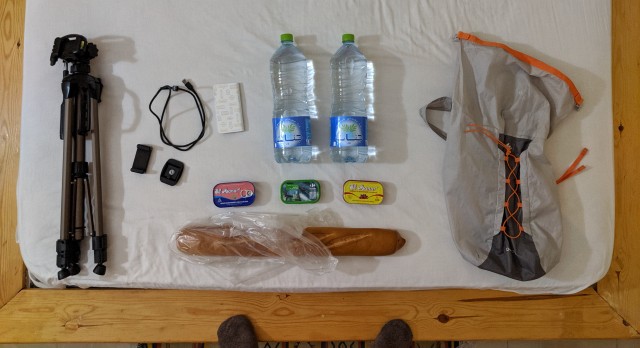
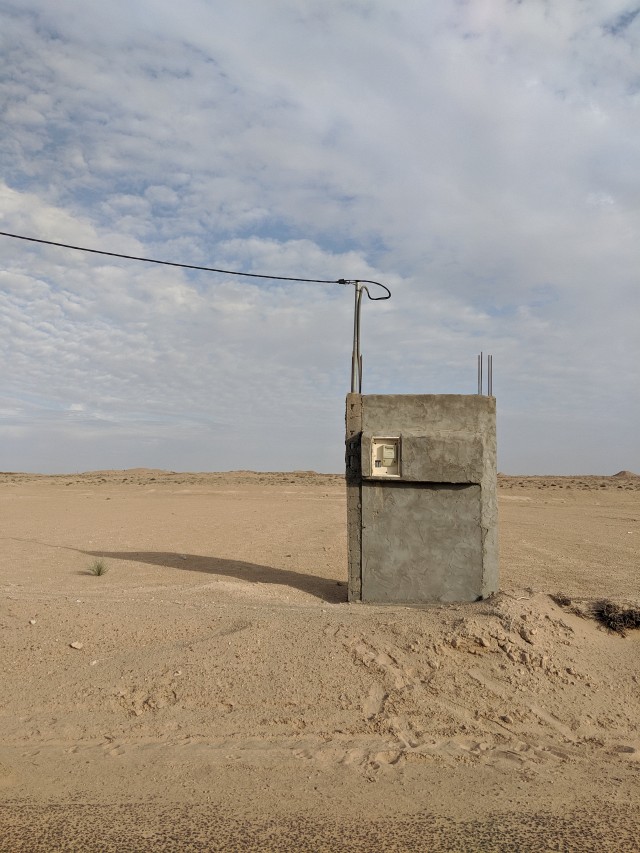
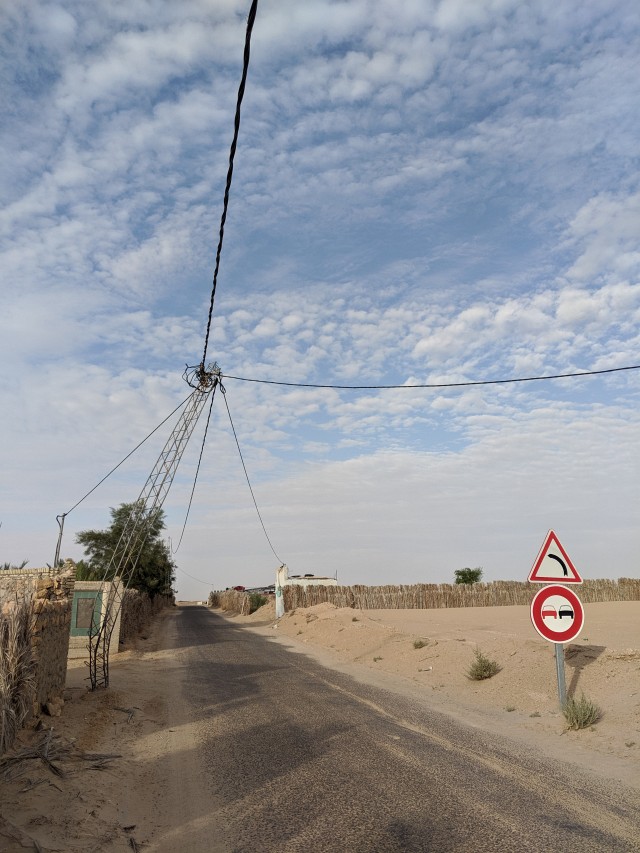
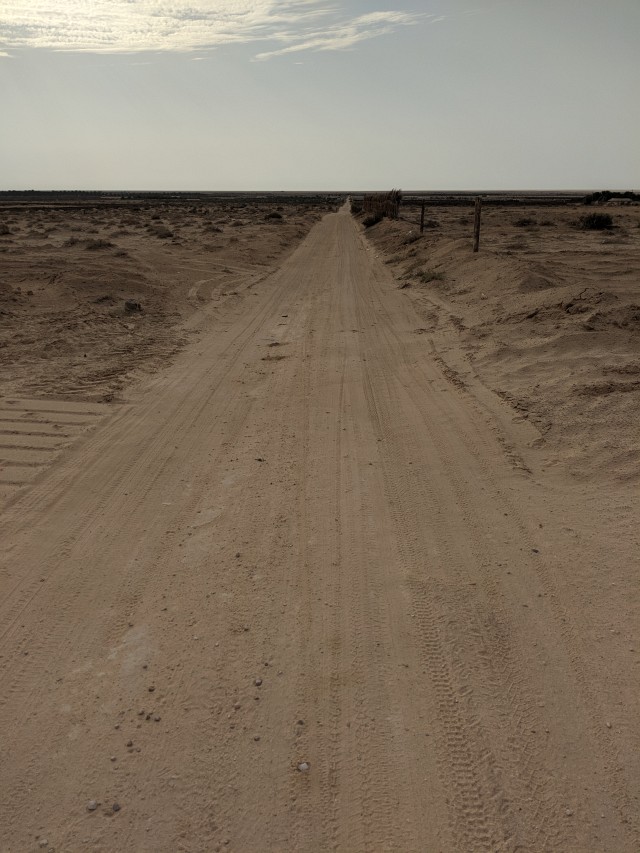
The stillness of the desert, the absence of automobile traffic, the quiet literal nothing. I’ll never forget it.
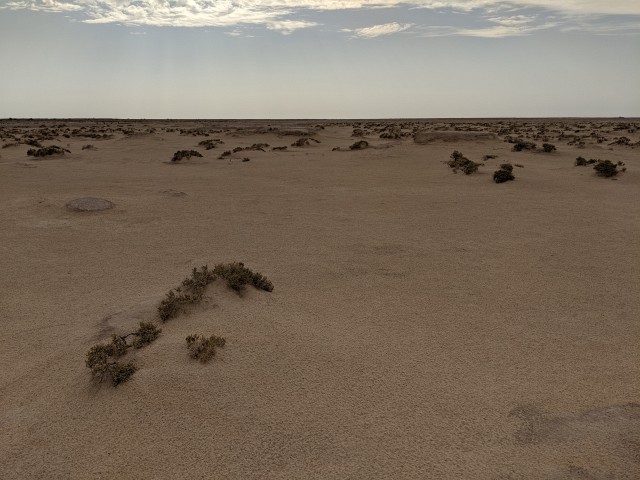
Kairouan
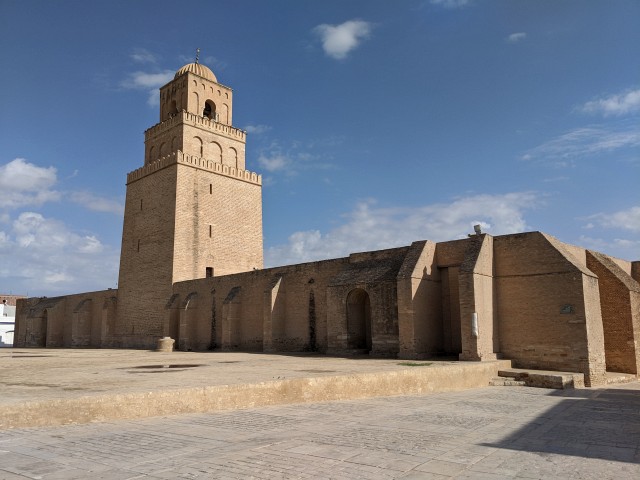
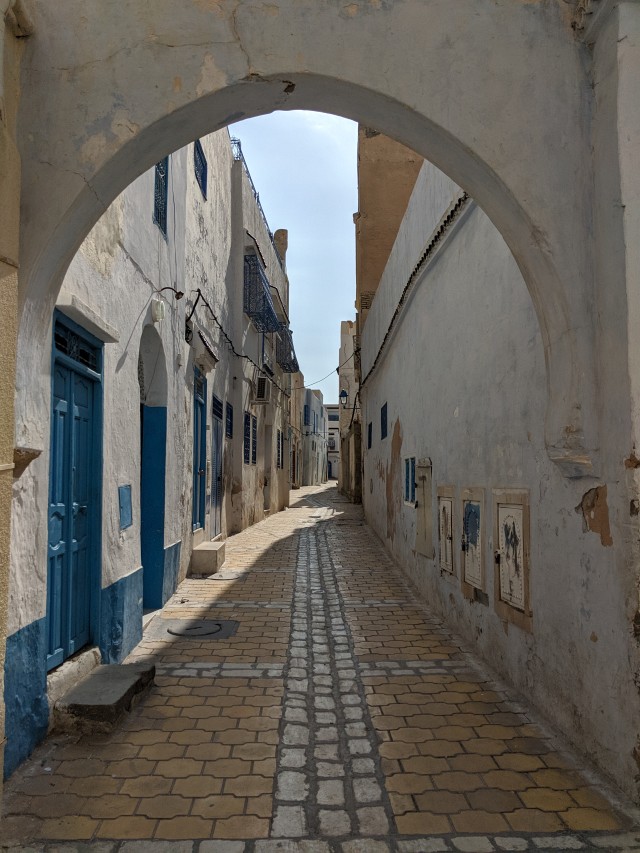
El Jem
Getting there from Kairouan? Go to Sousse first. Then go to El Jem. The louage system made this entirely painless, and the Station Louage in Sousse is clearly a main hub. You will not have problems getting transport.
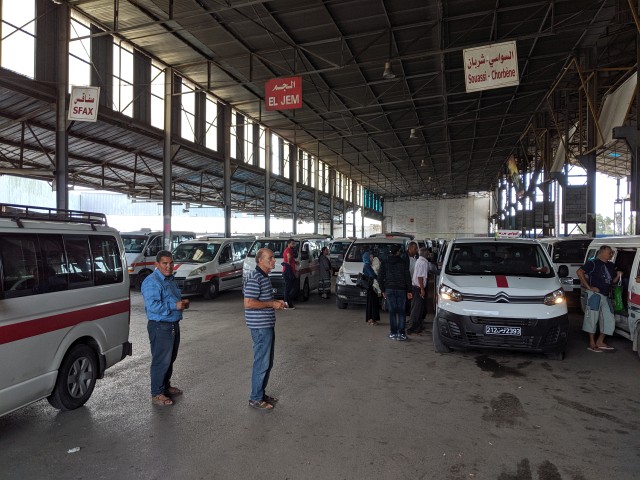
El Jem has one of the world’s finest remaining examples of Roman amphitheatre. It’s a nicer visit, in a number of ways, than the Coliseum in Rome.
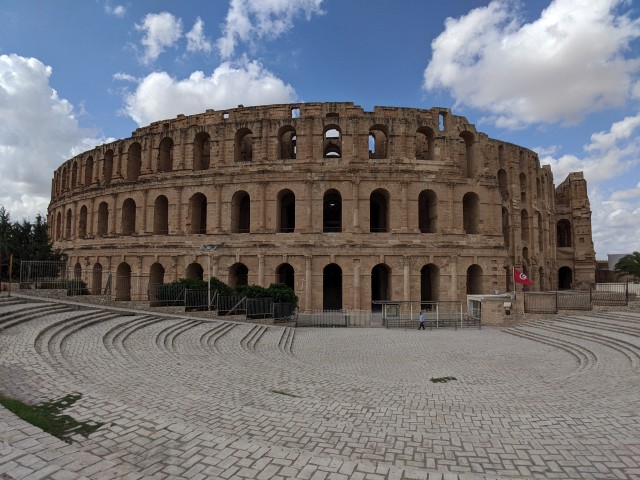
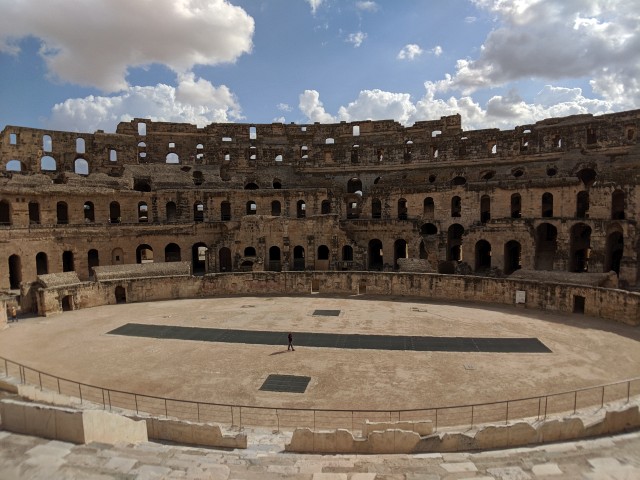
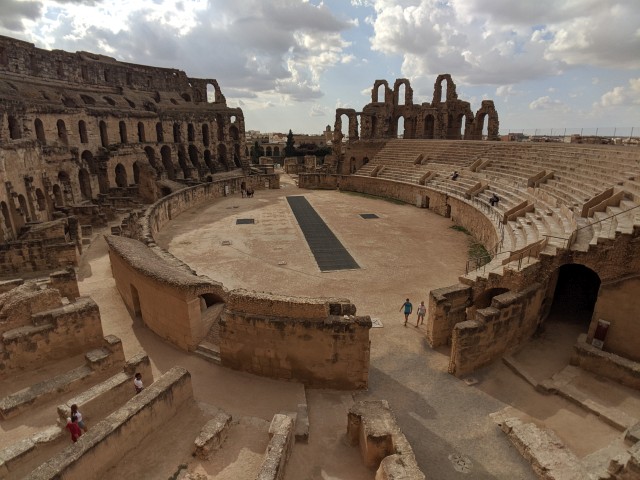
You can stand in the center of the amphitheatre and hear the crowd roar… "Maximus, Maximus!"
Tunis: Carthage
El Jem → Tunis for 10.450 DT on the slow train. Delayed by an hour and took 3 hours.
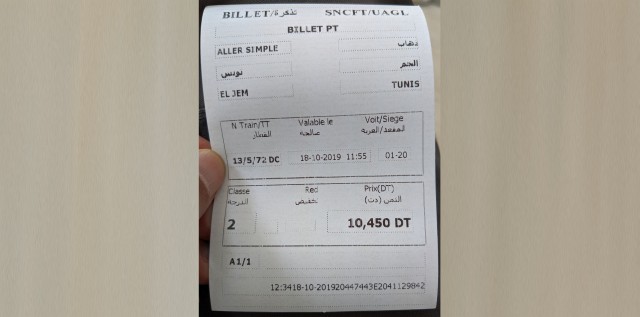
The ruins of Carthage on the Byrsa were… well, whatever. Somehow, the ruins of ancient urbanity didn’t speak to me.
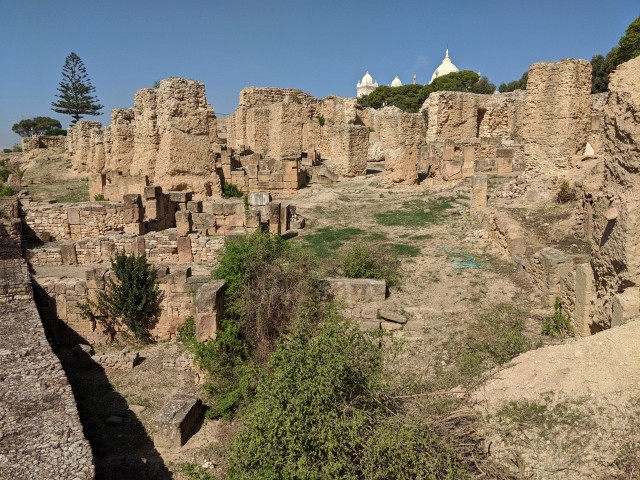
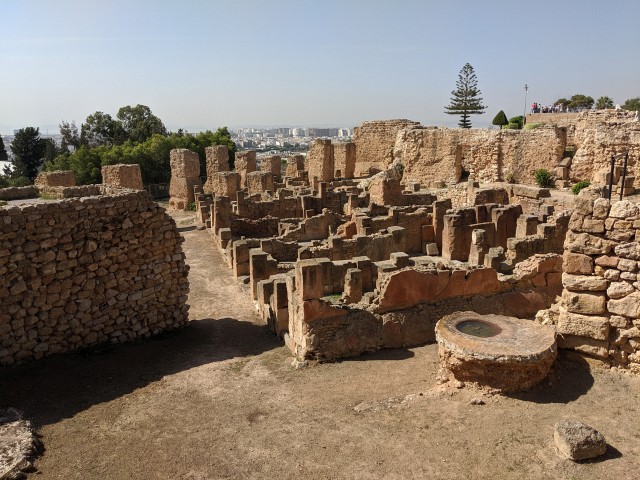
On the other hand, the ruins of the Roman aquaduct and cisterns. Holy cow. That is some serious engineering. I’m not sure whether the photos do it justice, but each cistern was massive.
Say what you will about their martial expansion, but moving this much earth and laying down this much concrete is a prime example of civil engineering supremacy. I have serious respect for the engineers that built this.
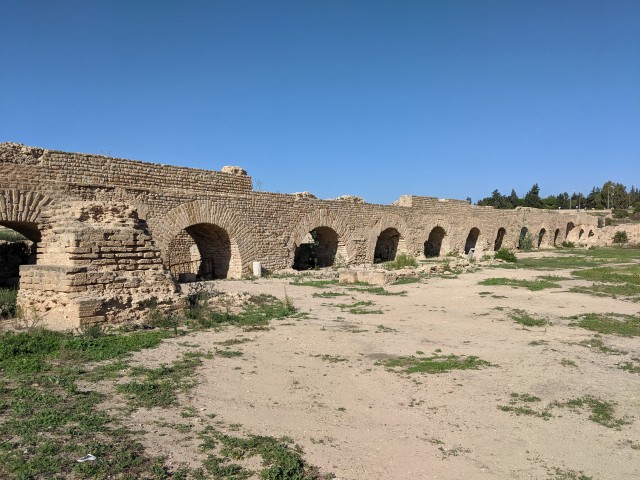
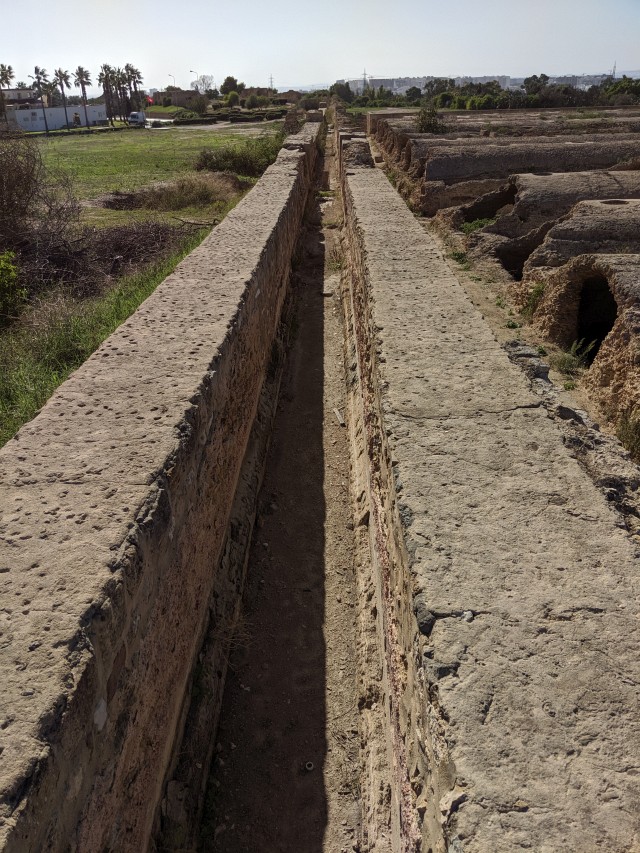
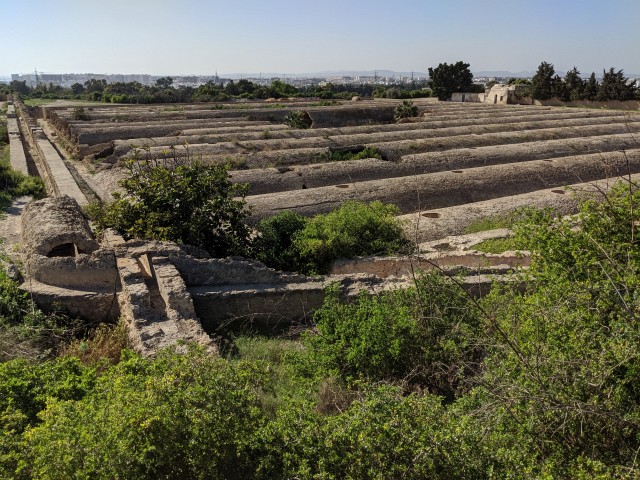
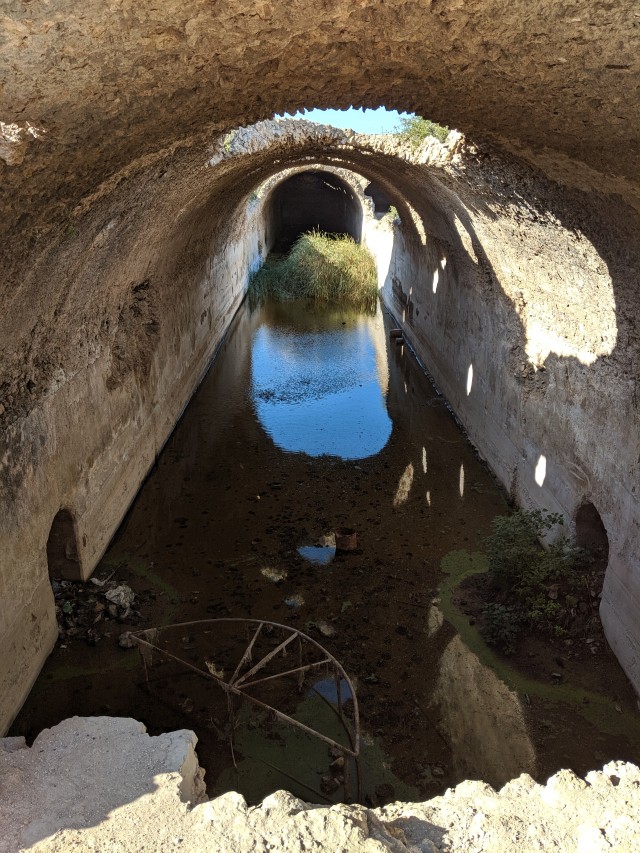
Coda
And after these final days, almost as quickly as it had started, my trip came to a close. After a short three hour flight, I was back on German soil. Tunisia is really close to Europe and I’m surprised that more people don’t visit.
Now, let’s talk about the food.
Food
The reason I travel, for the most part, is for the food. It is the one thing that does not survive transport and is one thing that still so strongly distinguishes a culture (and by extension, place) from another.
Even in a world as connected as this one, it is still impossible to move the sum total means, motivations, and supplies needed to make certain cuisines cheaply and easily in another place. There are exceptions, of course, but it generally holds true that you’re not going to get the widest array of food from one place in another.
Reasonable emulations of certain well-knowns, yes; authentic, on-the-money hits, no.
The Basics
Tuna — Tunisians eat a lot of tuna. It is, or can be, in everything. Every grocery store stocks canned tuna, sometimes in bulky half-kilo tins, and it’s pretty tasty if you like tuna.
Sugar — Tunisians love sugar. One of the first things I encountered in a grocery store there was a bulk hopper full of sugar, from which customers could sift however much sugar they wanted into plastic bags. They use it to make very sweet hot black tea and citronnade, a local lemonade like the kind you might get unlimited refills of in the states, but sweeter. That said, the portions are smaller (the tea usually comes in tiny cups), so… overall probably not as bad as the 20 oz. sodas you get in the States.
Pasta — My Tunisian friend told me a story about the presidential election in 2019, where one of the candidates (Nabil Karoui) was accused of using charitable and visible donations of pasta to attempt to sway voters in his favor. Ultimately, the gambit failed, but there were people who saw it as a positive, and not as the vote-buying attempt that it was. So it’s a thing, Tunisians eat a lot of pasta.
Olives — Tunisia grows a lot of olives, and generally the olives and oil are pretty good. Driving through the country, you see endless orchards and irrigation, everywhere. There is a country-level office in Sfax that deals with olive production and export.
Dates — Tunisia grows some of the best dates in the world, but it doesn’t look like this is going to be sustainable for too much longer.
Harissa — A uniquely Tunisian condiment, the spicy red chili paste goes well with just about everything here and there are a number of varieties available at different levels of heat.
Eggs — Similar to tuna, there are eggs in everything, or nearly everything.
The Limits
I wasn’t sure what the situation was, with respect to fresh vegetables in the country and whether the bulk of them were consumed locally or sorted and exported to wealthier markets. (Like the avocado situation, in Mexico.)
Often, I would see the best produce in the farmer’s markets, and the worst produce in the grocery stores. Vegetables usually came in the form of root vegetables (potatoes, carrots), summer squash (zucchini), or nightshade plants (eggplant).
Leafy greens, of the kind most Asians are familiar with, are all but non-existent. Which must have sucked for the busload of mainland Chinese tourists I ran into in El Jem. Also, no pork here, so double-suck for Chinese tourists.
Which is also to say, there’s very little in the way of non-local foods in Tunisia. The market for it is tiny, outside of the wealthier expat community.
Ok, so how do Tunisians combine the basic ingredients into a local cuisine?
Fricasse
Deep fried dough, eggs, tuna, olives, harissa, what’s not to like? If you can get a freshly-fried bun, you’re in luck.
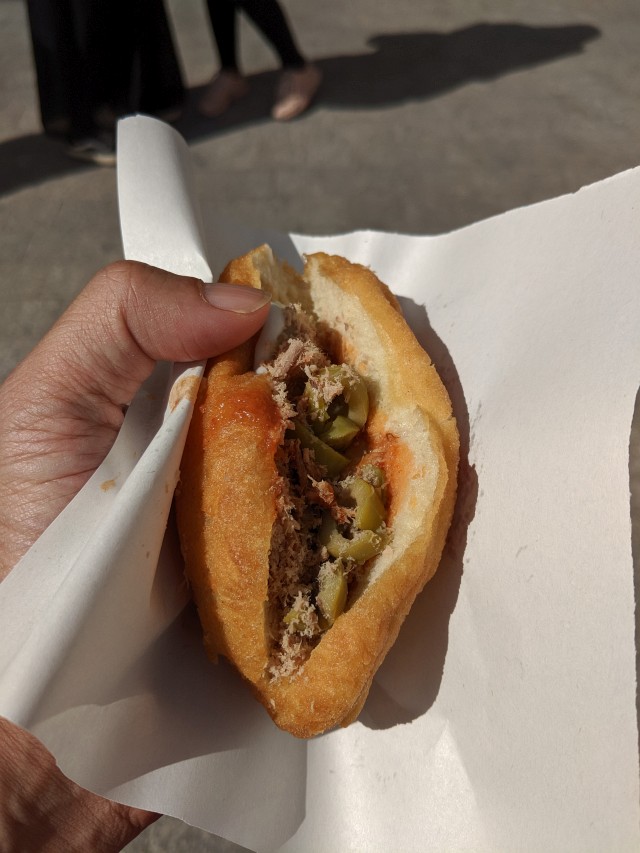
Sandwiches
Baguette bread, tuna, olives, harissa, onions and lettuce, maybe even some fries. It’ll fill you up.
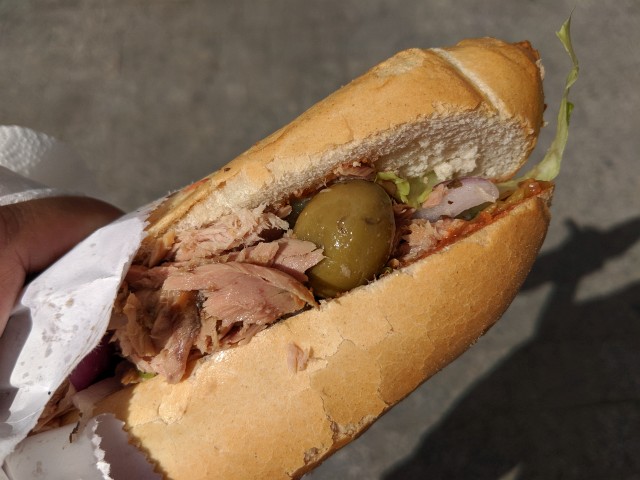
Lamb Schwarma (d’Agneau) in Tabouna Bread
These schwarma sandwiches were in Monastir, and damn were they tasty. Along with crispy fries and tzatziki… 👌🏻😘
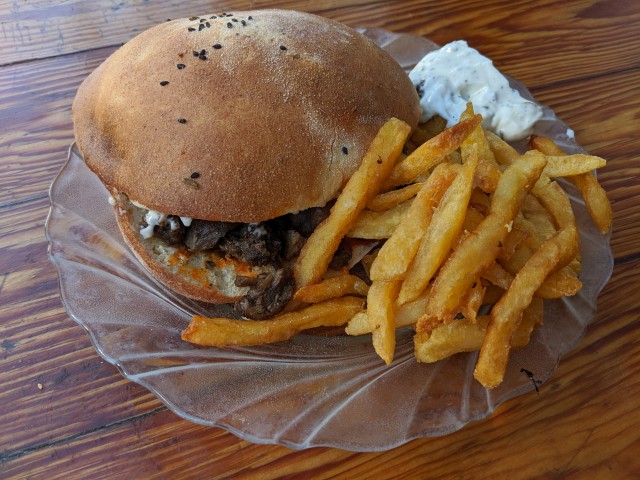
Brik
Filo dough, filled with an egg, tuna, herbs, and deep fried.
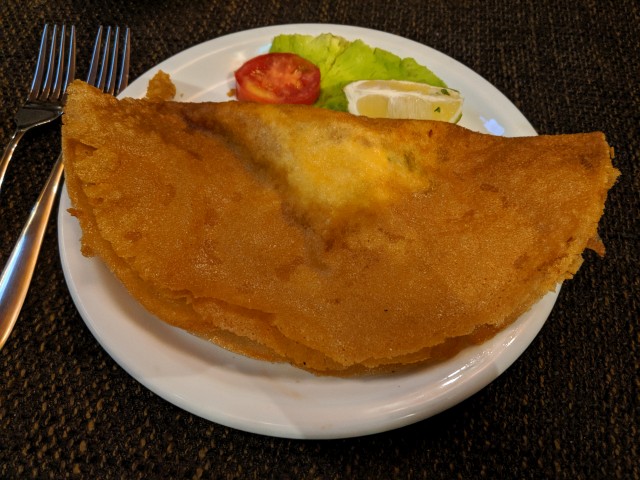
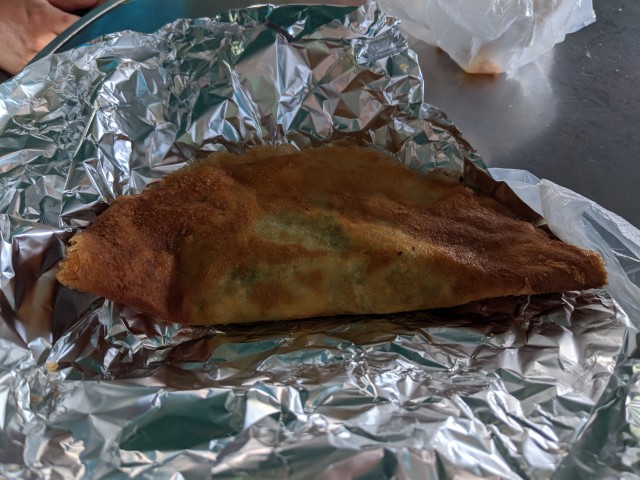
Bambalouni
Look ma, donuts. With or without sugar or dipped in chocolate. The fresher the better, of course.
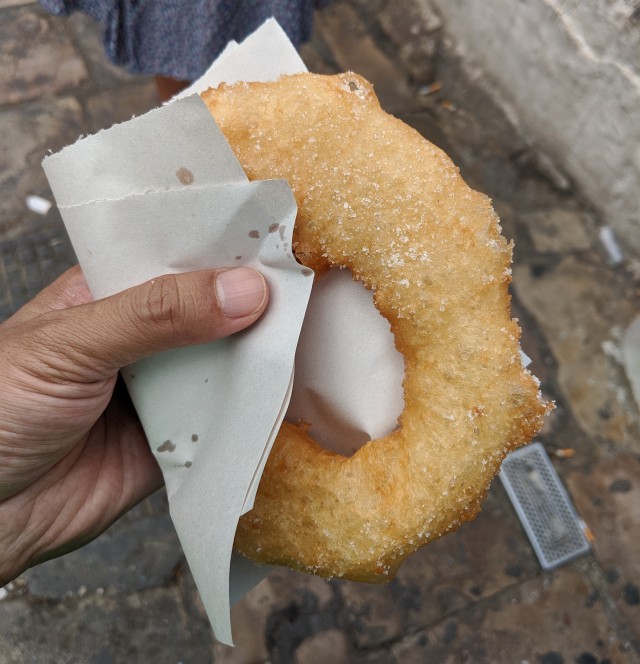
Harissa
From what I could see, all of the harissa varieties had over 80% fresh red chili peppers in their lists of ingredients.
It might even be the law, I’m not sure.
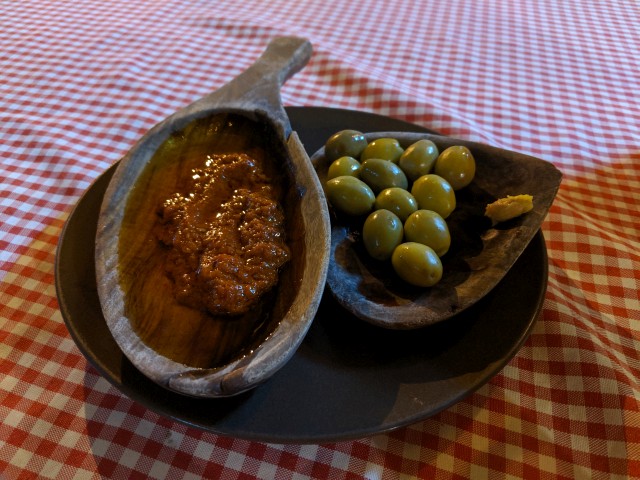
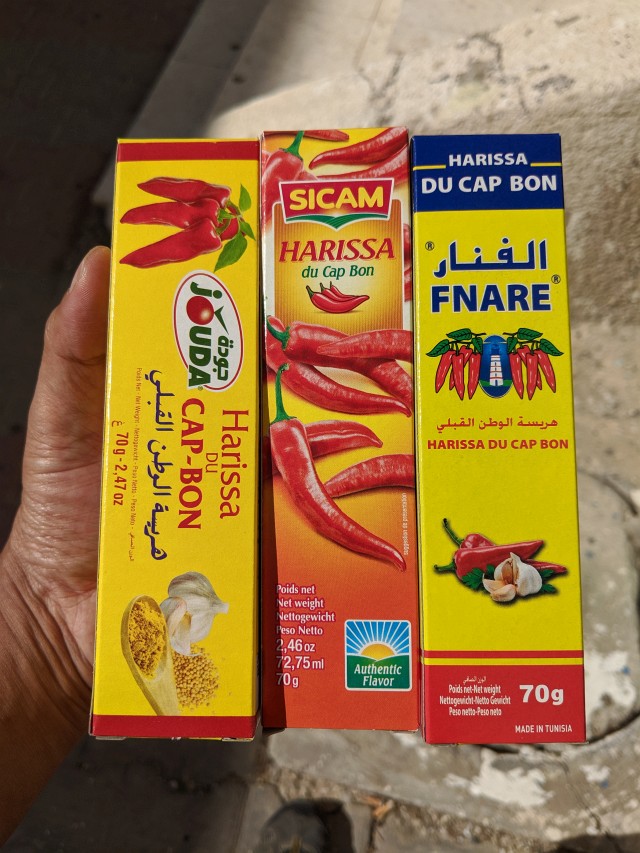
|
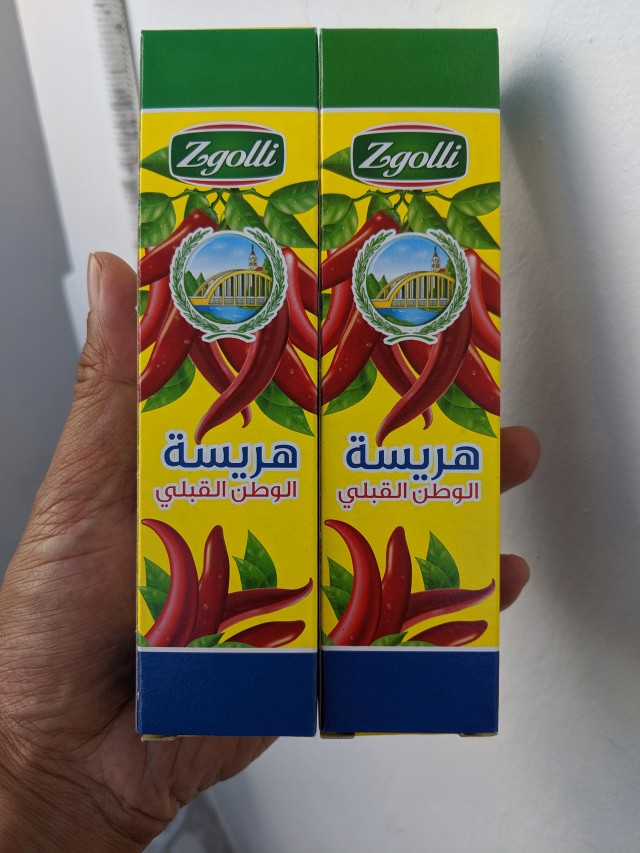
|
Mechouia
A grilled vegetable salad, reminiscent of a tapenade or baba ganoush. Usually with green sweet peppers of some kind, which lend a slight bitter flavor to the mix.
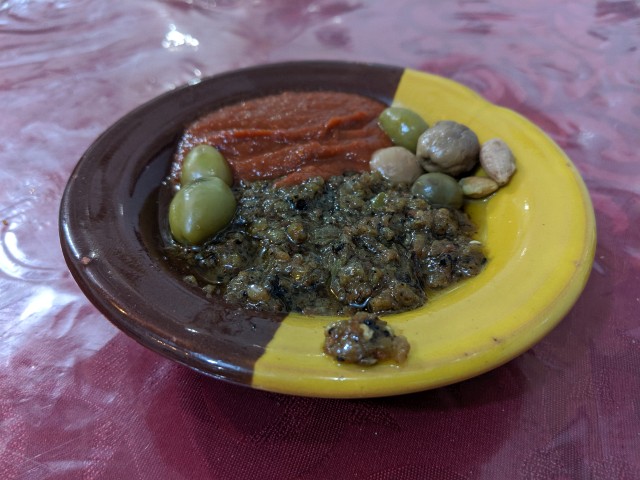
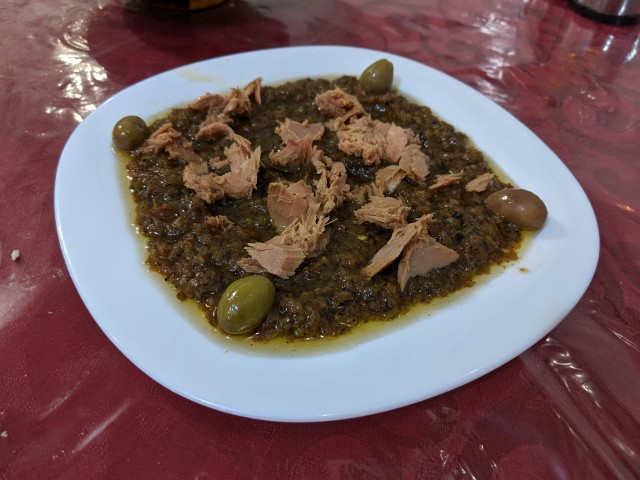
|
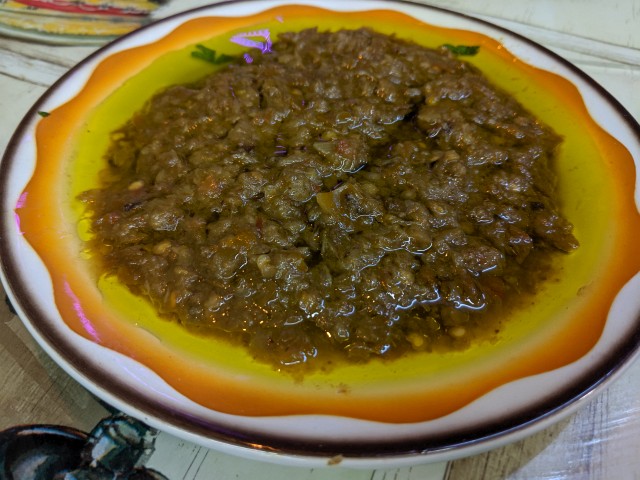
|
Tastira
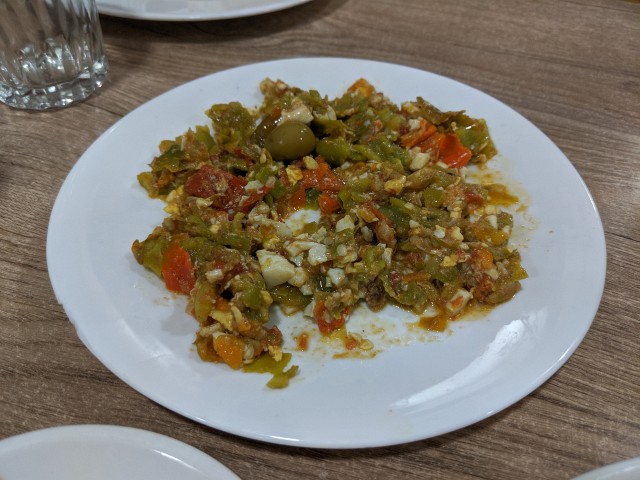
Chorba
Yup, it’s the same root word and same recipe as Turkish mercimek çorbası.
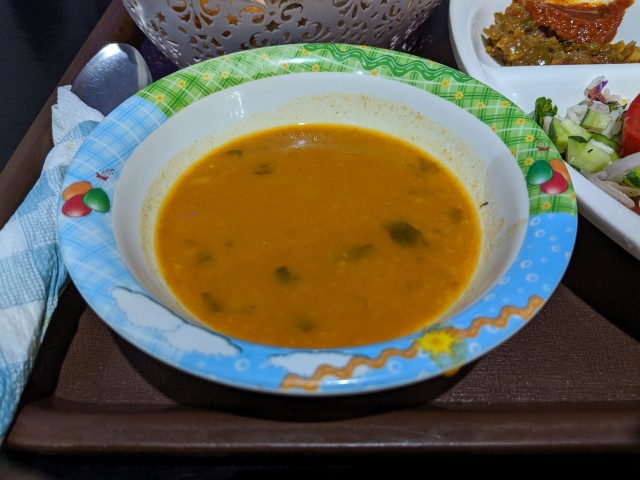
Coffee + Tea
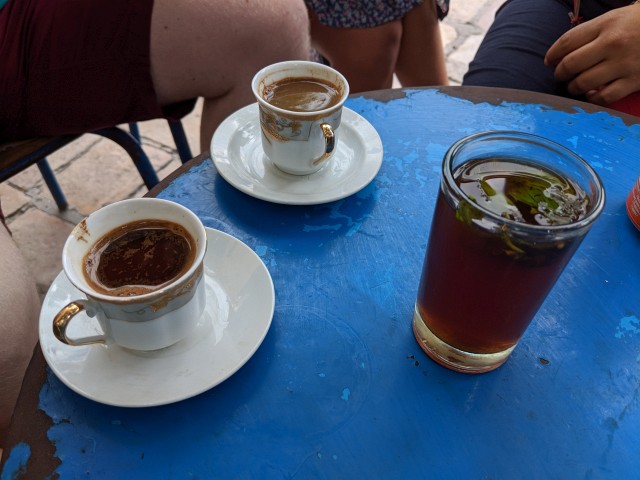
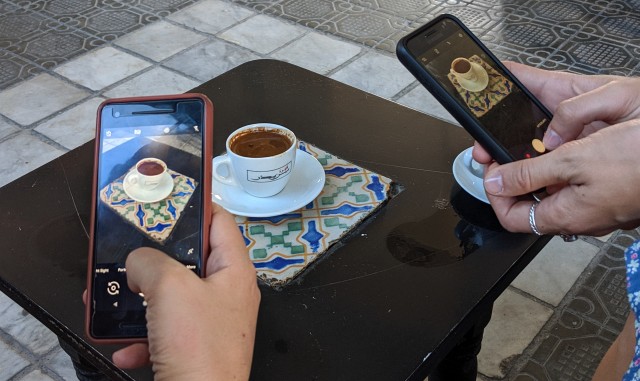
Citronnade
Like Minute Maid lemonade… but sweeter. Somehow didn’t manage to get a picture of it, but just imagine a short glass of lemonade.
Makroud
I’m not sure why no one told me about these at the start of my trip, but properly-made makroud baked sweets are utterly delicious. They totally kick baklava’s ass.
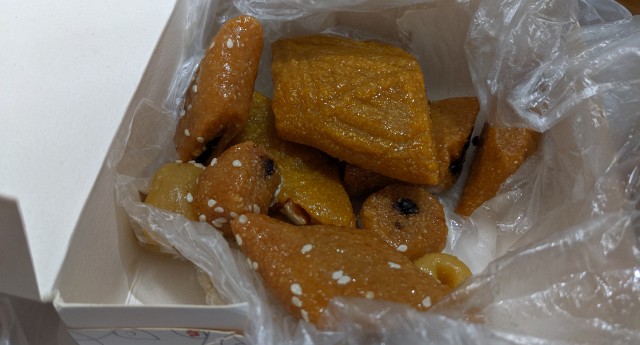

Lablabi
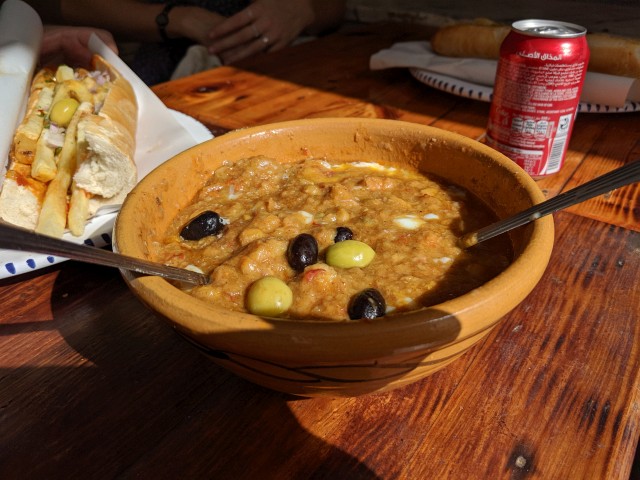
I do not like lablabi, which is a thick and mucilaginous stew made with chickpeas, I assume that the aquafaba is given a chance to thicken the whole thing. Usually an egg and a bit of bread is broken up and placed in the bowl before the stew is ladled in.
For me, this is a big bowl of nope.
Malfouf
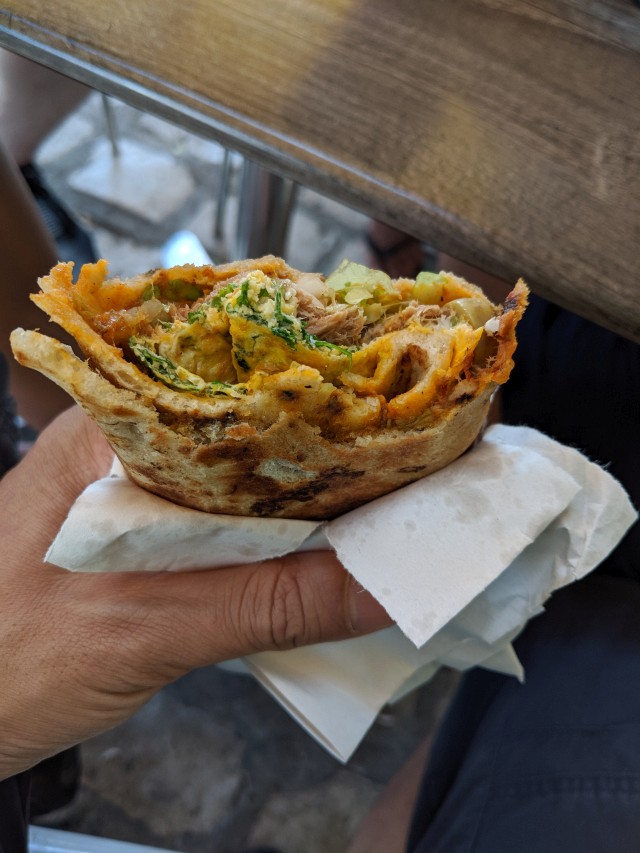
Makloub
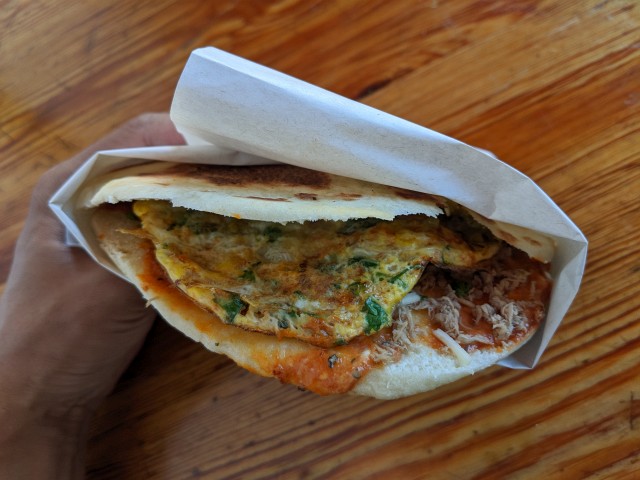
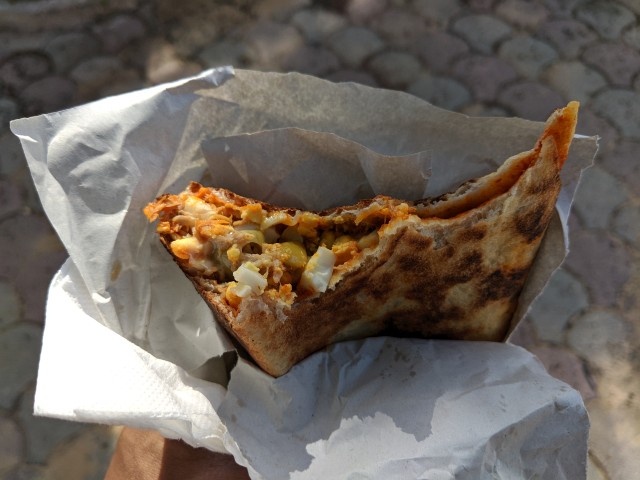
Couscous
The couscous in Tunisia is finer-grained than the stuff I’ve had elsewhere, and somehow that makes me like it more. Infused with stock or sauce while it cooks, it tastes pretty good, and usually the portion will be overkill.
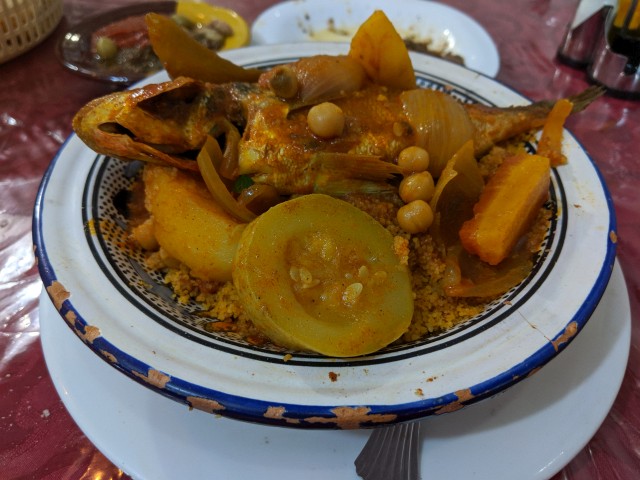
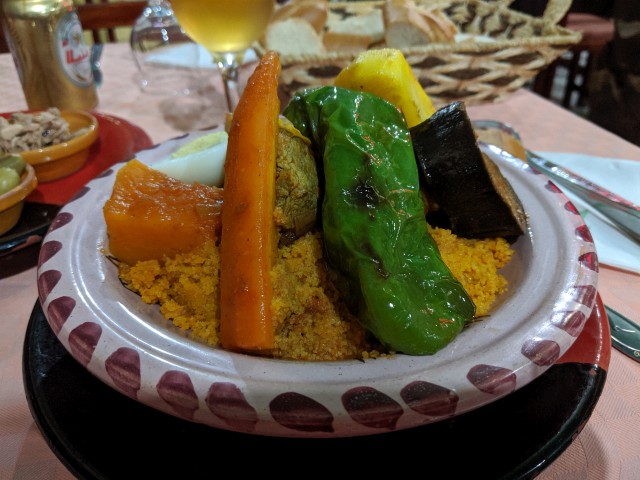
Kabsa
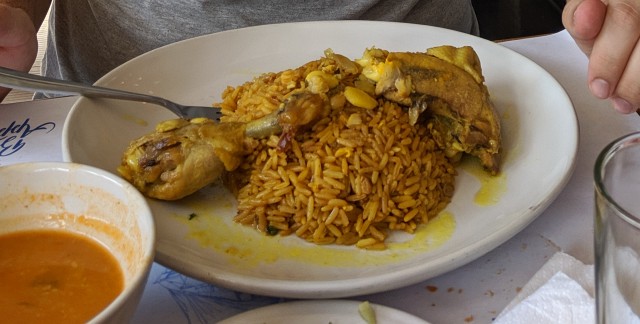
Madfouna
Which means "buried", which is kind of a play on what it looks like. (morbid.) It’s a stew made with beef meatballs, beans, animal hoof, and a slightly minty sauce.
See that shimmering layer of congealed gelatin on top? That’s the hooves.
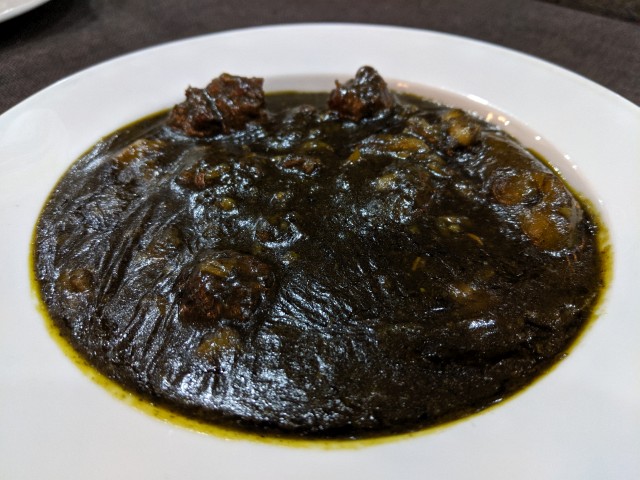
Mloukhia
Looks the same as Madfouna, but isn’t. In Tozeur, you can get it made with camel meat, which tastes like mutton.
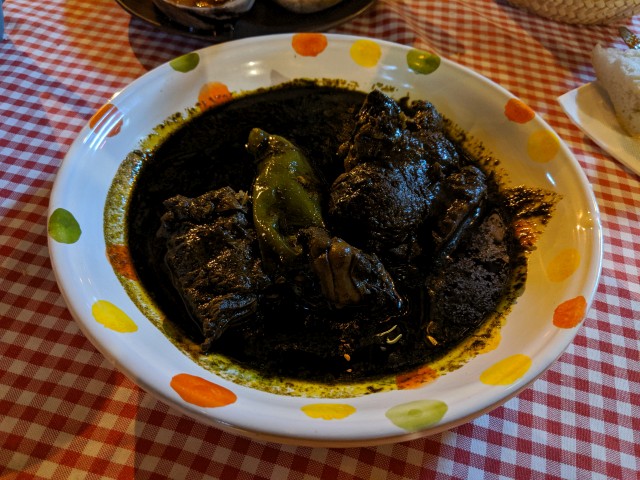
Jarra
Special to Tozeur, this is a clay pot dish made with root vegetables and cuts of meat, served piping hot. Worth getting the camel. Pretty good.
Fish
Lots of this stuff. Fried. Grilled. Good.
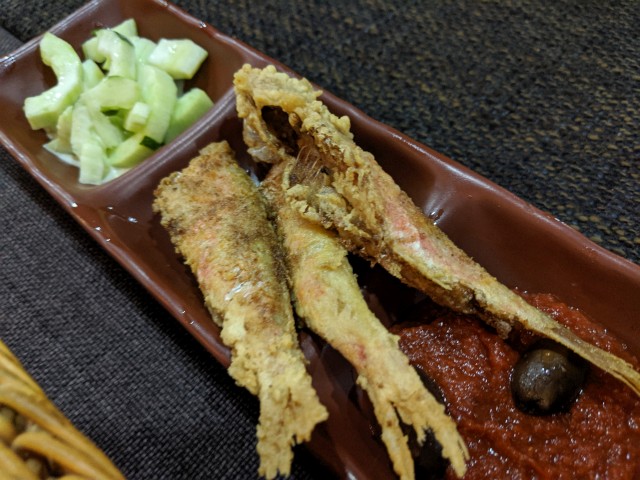
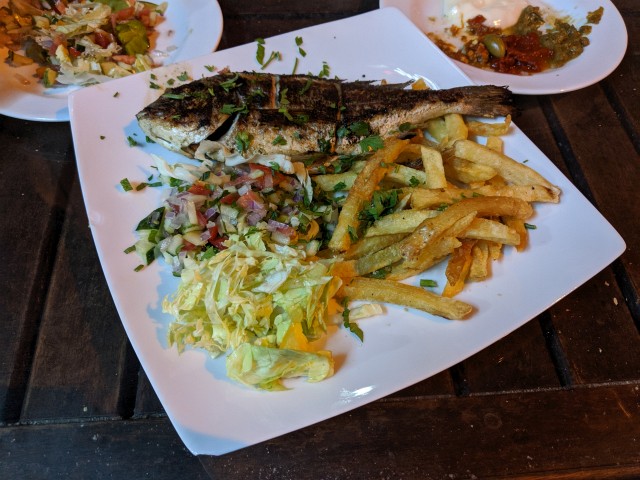
Ojja
It’s an egg and stuff dish, similar to shakshouka, usually made with local merguez sausage.
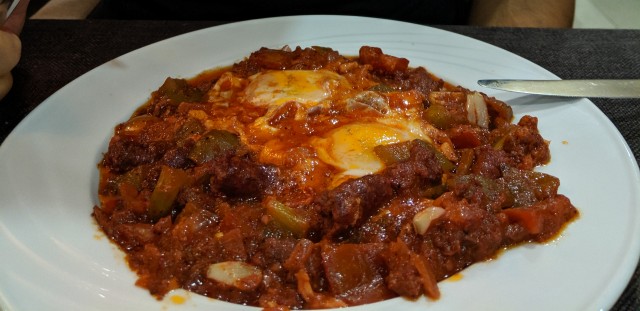
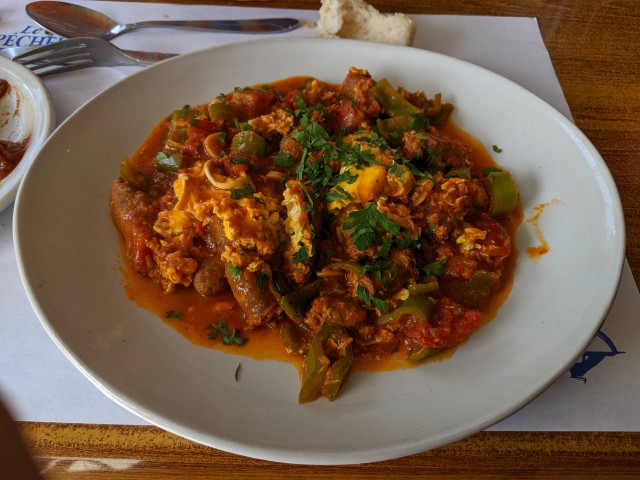
Barbecue
A number of barbecue restaurants line the road to the Hammamet Marina. I got the sense they didn’t actually salt the meat. 🤨
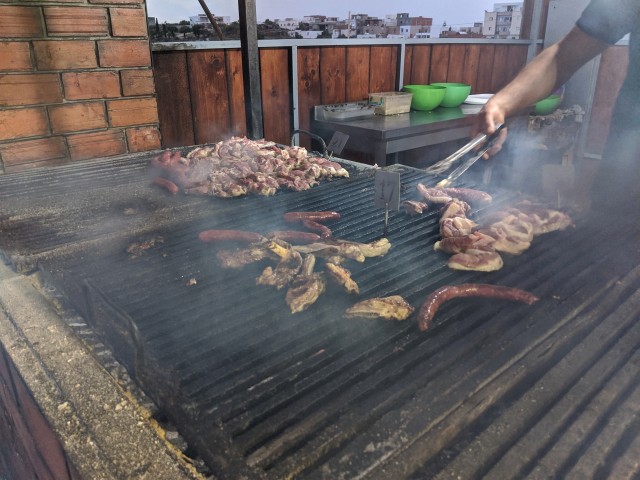
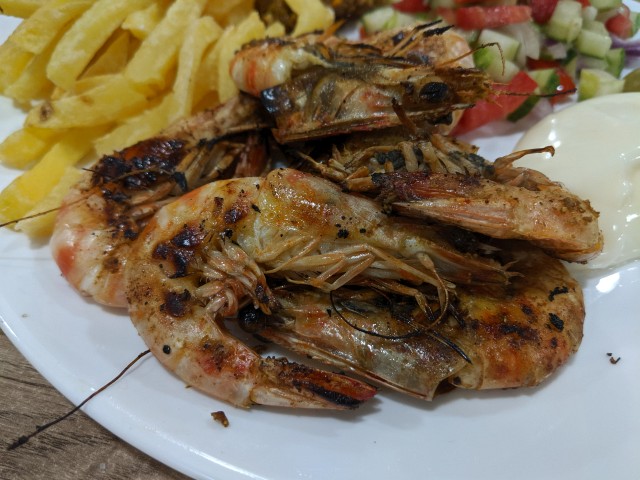
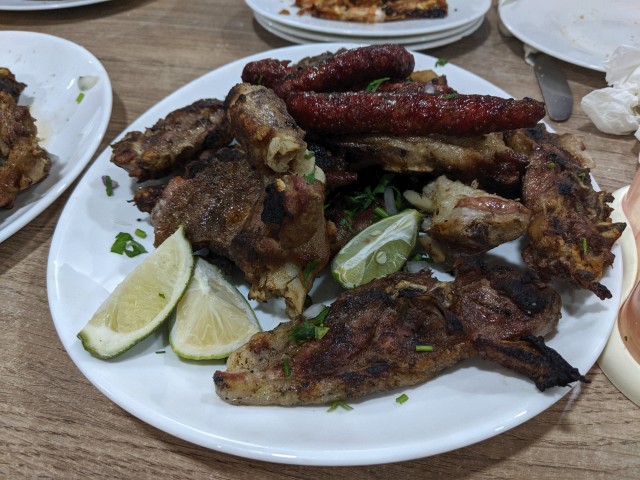
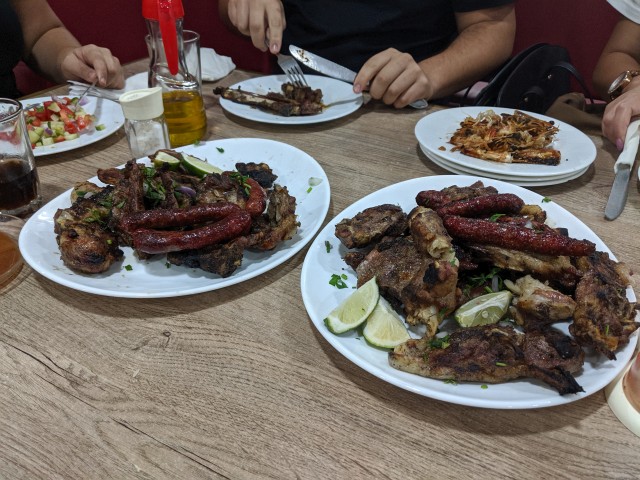
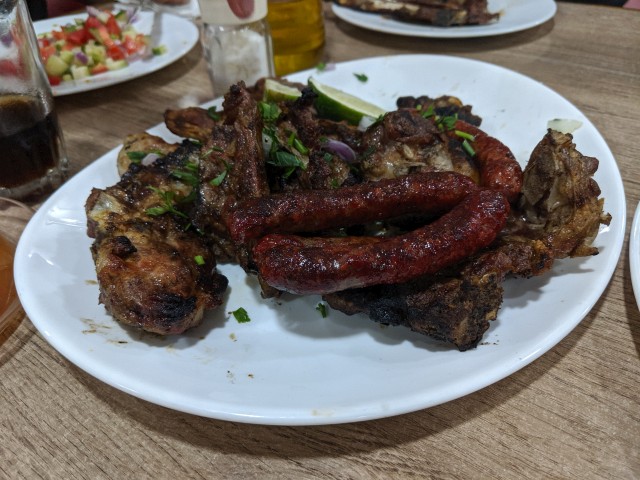
Rotisserie Chicken (Poulet rôti) + Mechouia
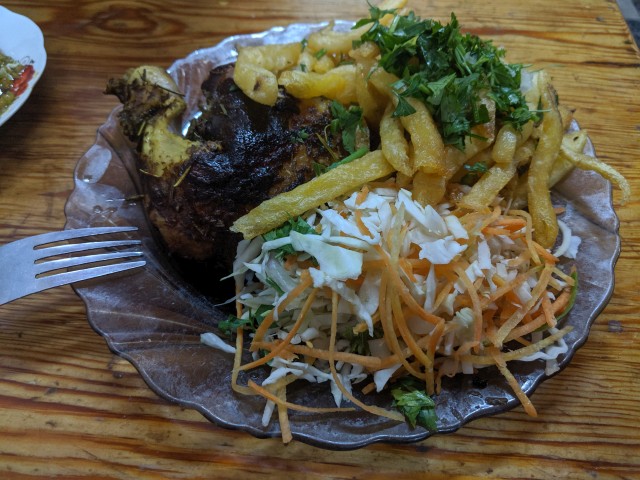
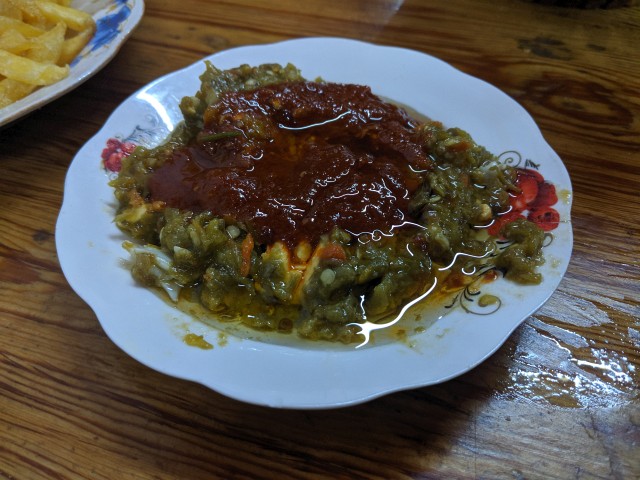
Junk Parts
Literally a hole-in-the-wall restaurant in Kairouan, serving up roasted junk parts of chicken, including the necks and ribcages (leftover after removing the breast meat).
Tasty, but this was actually the one that gave me an upset stomach. Worth it, but one time only.
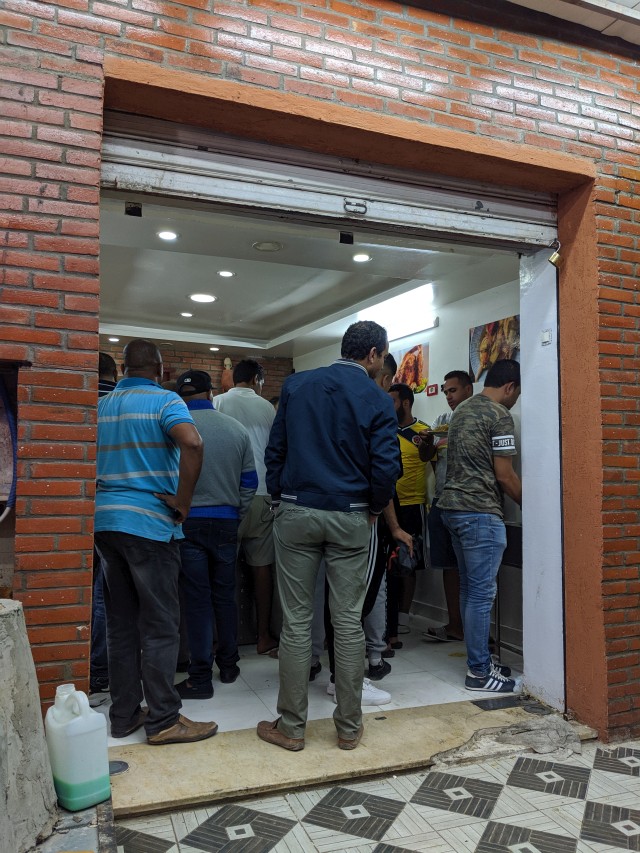
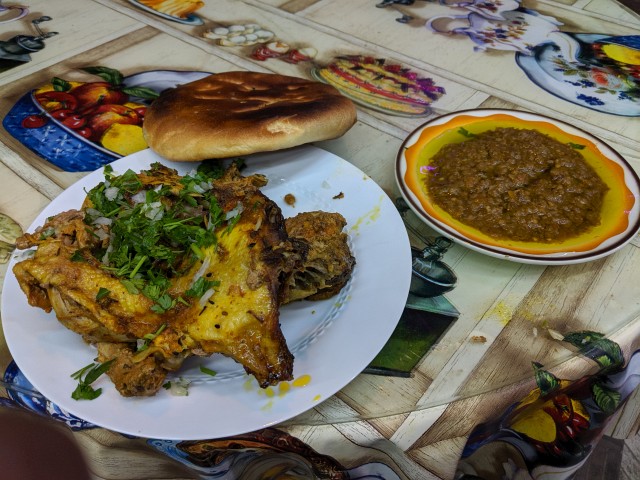
Things I Didn’t Get To Try
Before I traveled to Tunisia, I’d drawn up a list of dishes I wanted to try, and I managed to try most of them, with the following exceptions:
-
Felfel mahchi — Bell peppers stuffed with meat.
-
Gnawiya — Lamb or beef stew with mini okra.
Mini okra is a local ingredient I’d seen in the markets, and is something I have never seen in Europe. It was reminiscent of seeing flor de calabaza for first time in a Mexican grocer, as a local ingredient that you rarely see elsewhere.
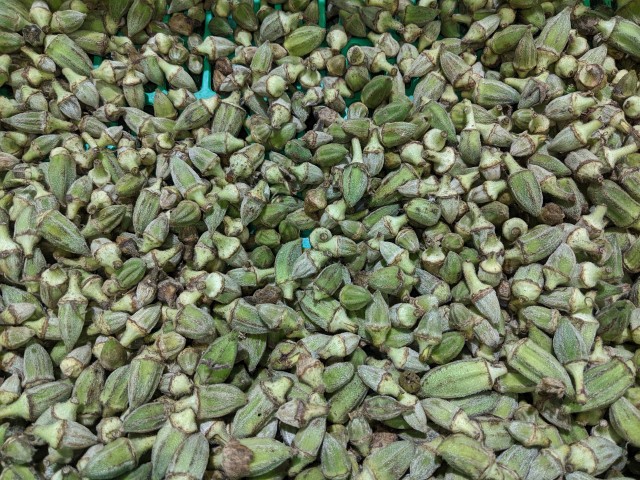
-
Koucha d’agneau — Lamb shoulder stew
-
Makoud — A form of chicken and egg quiche
-
Marqa — A meat and potato stew, with green peas
-
Osbane — Reminiscent of haggis, large intestine stuffed with other offal and grains. Also reminiscent of Korean sundae.
-
Zitounia — A meat and stew with olives in the sauce.
Also, I did try Kamounia, which was a beef and liver stew, and which had way too much liver in it and Riz Djerba, which is reminiscent of Jollof rice from West Africa, but I forgot to take pictures of them. And since pictures or it never happened, then it never happened.
Random Observations
A few thoughts about the current state of Tunisia.
Security, Part 2
Pretty much all of the high-end malls in Tunis had metal detectors on the way in. I always had to scan my backpack and water bottle.
The Other Tourists
Of the other foreigners I would see wandering around in Tunisia, the bulk of them seemed to be French and Russian, based on the amount of those languages I heard in passing.
Garbage, Garbage Everywhere
It’s unfortunate, but waste removal is limited and plastic waste is seen everywhere. I lost count of the number of plastic bags I saw wrapped around cacti. Refuse was strewn along roadsides, highways, and railroad tracks, and the rail lines would run past open fields filled with construction site refuse.
I saw this everywhere, and it definitely bothered me to see empty fields turned into refuse piles. What it points to, I believe, is a weakness in the rule of law and insensitivity to a tragedy of the commons. I have the same sense of revulsion to this as to the people in Berlin who leave their dogshit on the sidewalk. You know who you are, and you just don’t care about other people.
No Netflix. No Spotify. Currency Problems.
It may seem like a trivial problem, not having access to these services, but it belies a bigger problem for innovation in Tunisia. How do you sell products and services online, if you are subject to currency exchange limitations and cannot use banking services in a target market?
At the time of writing, Tunisia has highly limited currency exchange and the exchange rate is fixed. I have also read that there is a maximum amount of dinars that a Tunisian citizen is allowed to exchange per year.
Foreign reserves are so low and the risk of capital flight so high, that most subscription services that we take for granted in Europe are not available there. Netflix and Spotify are accessible, i.e. the internet is open and free, but the services can’t be paid for in dinars.
Someone told me, as well, that when traveling to Europe, a Tunisian would have to bring the bulk (and possibly all) of the money they would need with them, as the banking system does not hook into the standard global ATM networks.
I thought that this was bonkers. I take it for granted that the money I’ve saved is trusted as a unit of exchange everywhere, which just isn’t the case for all countries.
Making Small Change Is A Pain
I’m not sure what the cause of this one is, but everywhere you go, even grocery stores and restaurants where you would expect at least one cashout purse to be around, breaking bills is a pain.
If you’re the unfortunate recipient of a 50 dinar note, you will have a hell of a time getting rid of it in regular transactions.
Even smaller bills down to 20 dinar may also have issues within a city. When the average price of a fast meal is 1.300 - 2.500 dinar, people may not enjoy passing you a fistful of change.
Things They Could Make
There were definitely all of the ingredients necessary to make flour tortillas, and I kept seeing rows upon rows of cactus plants in the desert, everywhere I went.
Nopales would be possible. But there are just no Mexicans around to show them how to do it.
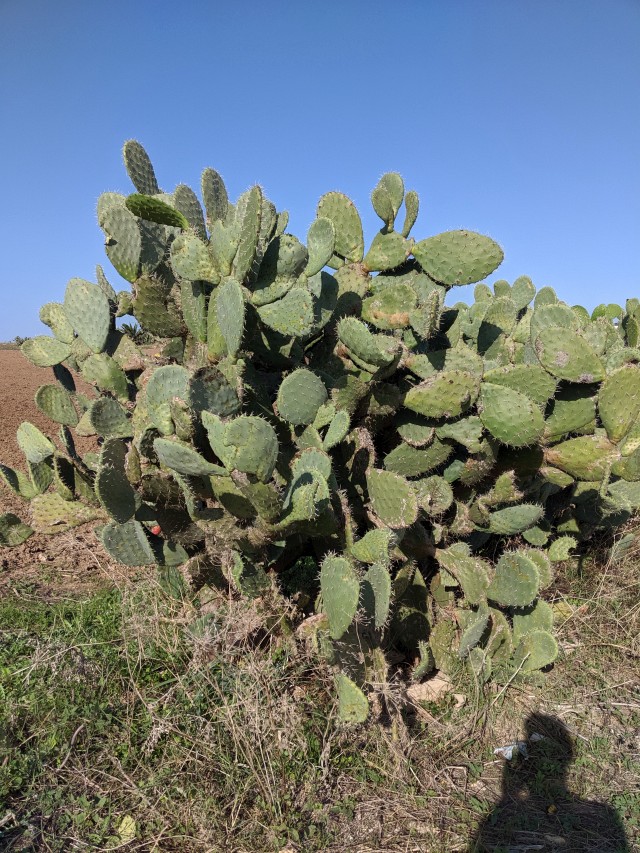
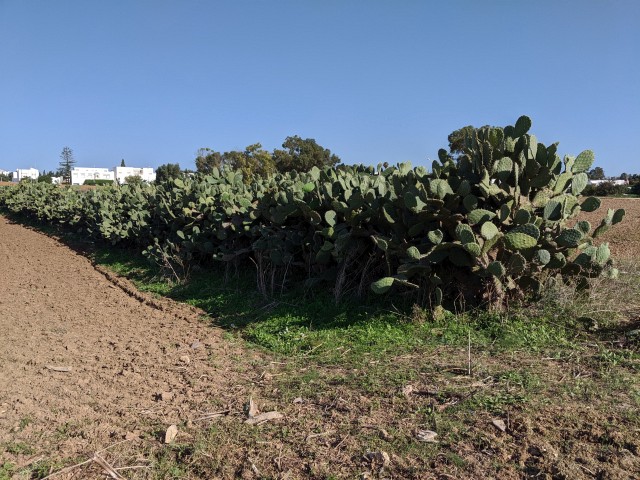
The prickly pear cactus is grown in rows as boundary markers at the edges of fields and grows wild in the desert. The fruit is sold in markets all over the country.
Things They Could Make, If They Weren’t Haram
I saw massive agave plants. Tequila or mezcal would be possible. I would love to know what this would taste like, and what you would call it.
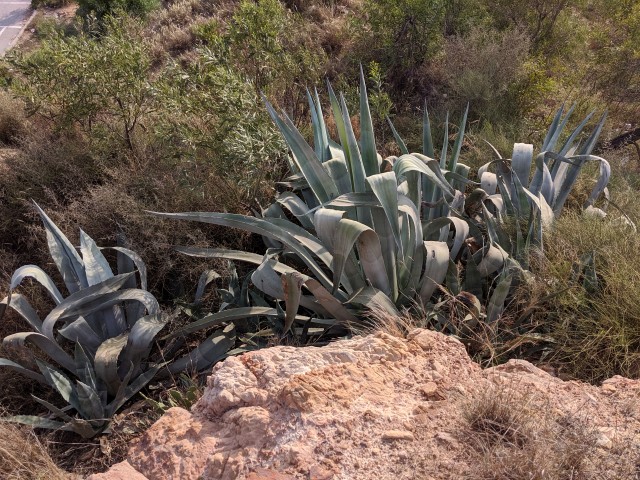
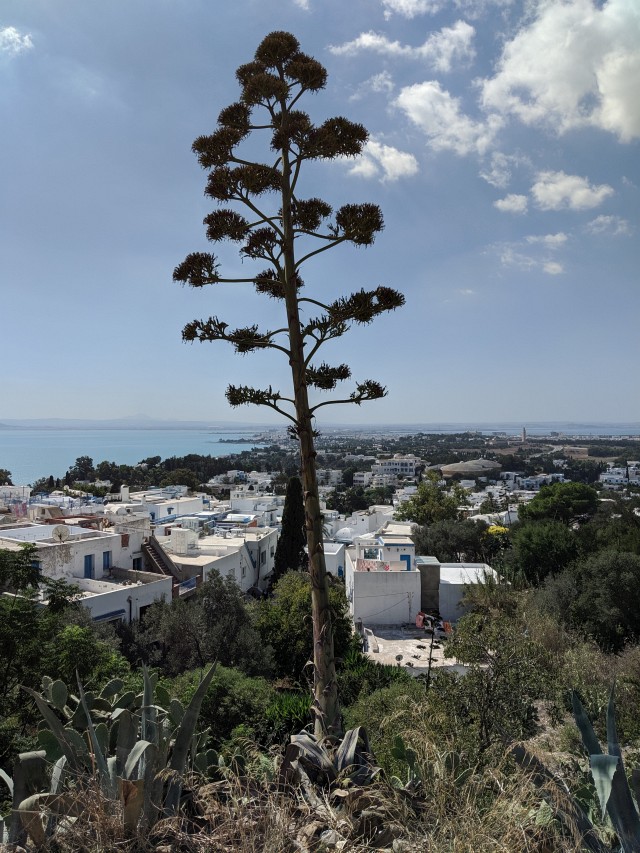
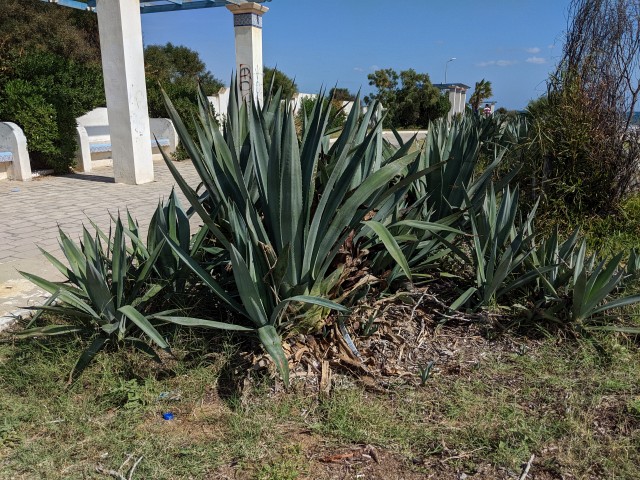
Saving Plastic: Boiling Your Own Water Edition
I’ll toot my own horn here. Reusing PET water bottles is a thing. I’d probably be smarter to use a BPA-free polycarbonate bottle, but whatever.
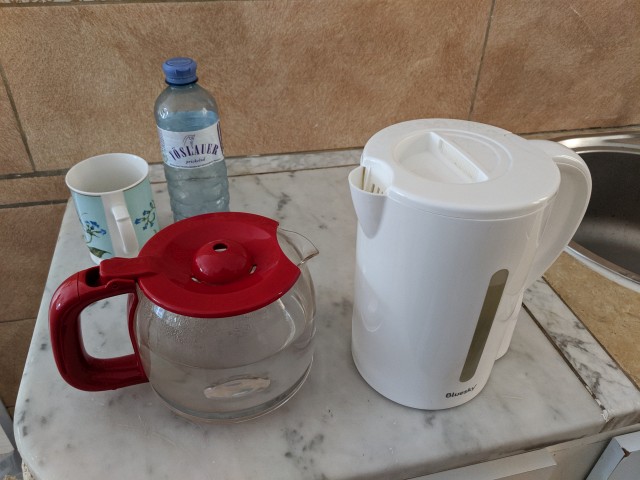
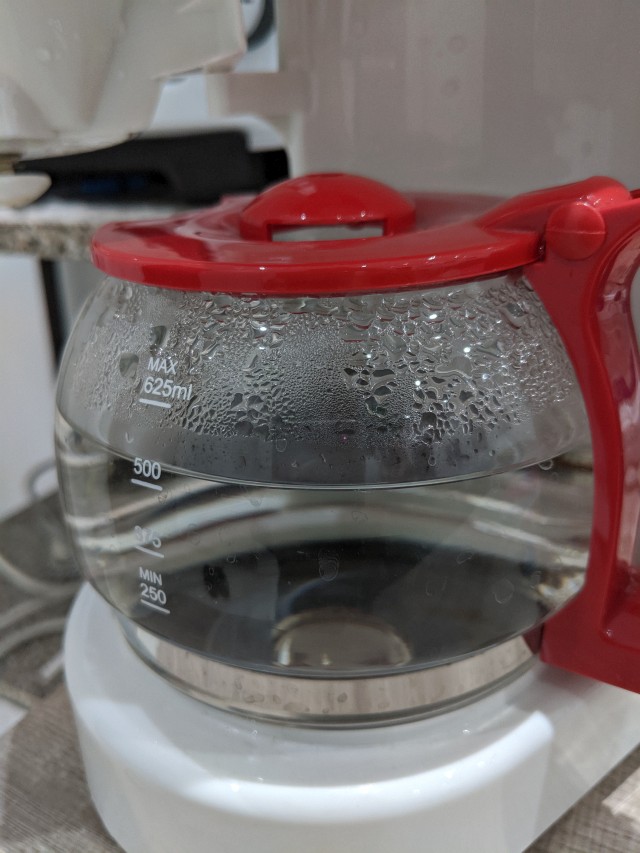
Unfinished Construction
Something I noticed, all over the country, was unfinished construction. Houses with second floors exposed, concrete pillars with rebar sticking out, and commercial buildings with similar features.
I’m not sure why this was such a common thing to see, but it wasn’t limited to new buildings. There were buildings with this phenomenon that had clearly ended their primary construction years earlier.
The Leftovers
Ignore my friends walking in the first photo, the most obvious feature of Sousse that you notice when walking along the beachfront, is the number of derelict hotels that line it.
This is upsetting, because you know the reason why.
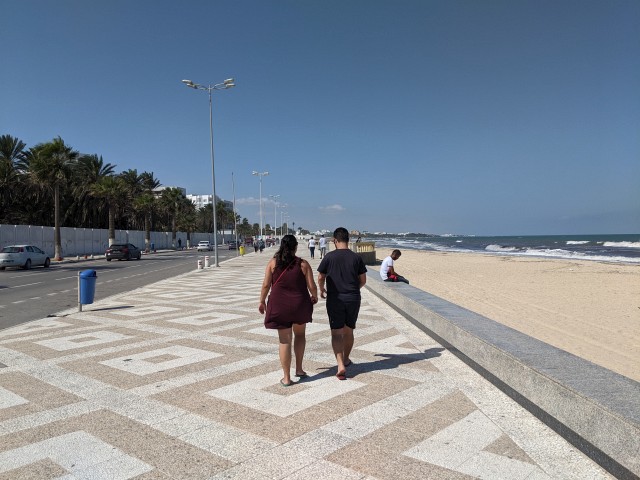
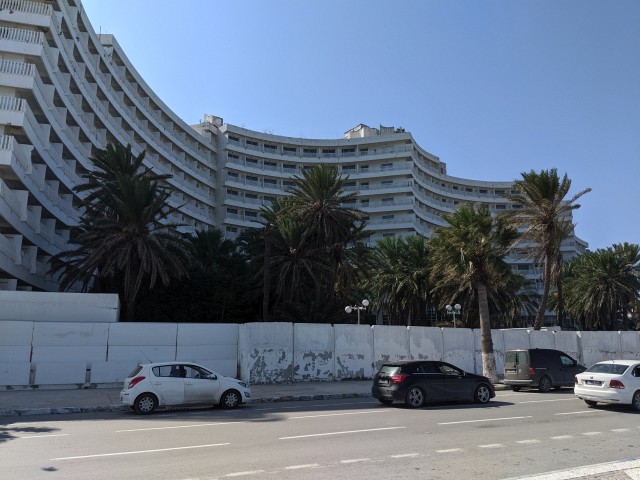
Sideline Gasoline
In Tozeur, the primary mode of transport seemed to be motorbikes and gas-powered mopeds, which are highly maneuverable and useful in the palm plantations.
Coincidentally, there were a ton of these tiny stands selling gasoline by the liter, which had me wondering exactly what the supply-chain looked like, and what truck the gasoline might have fallen off.
The going rate was ~ 0.60 EUR per liter of fuel. I wasn’t entirely sure what the difference was between the two types, but suspected that one might be for two-cycle engines?
Entrepreneurship at its finest.
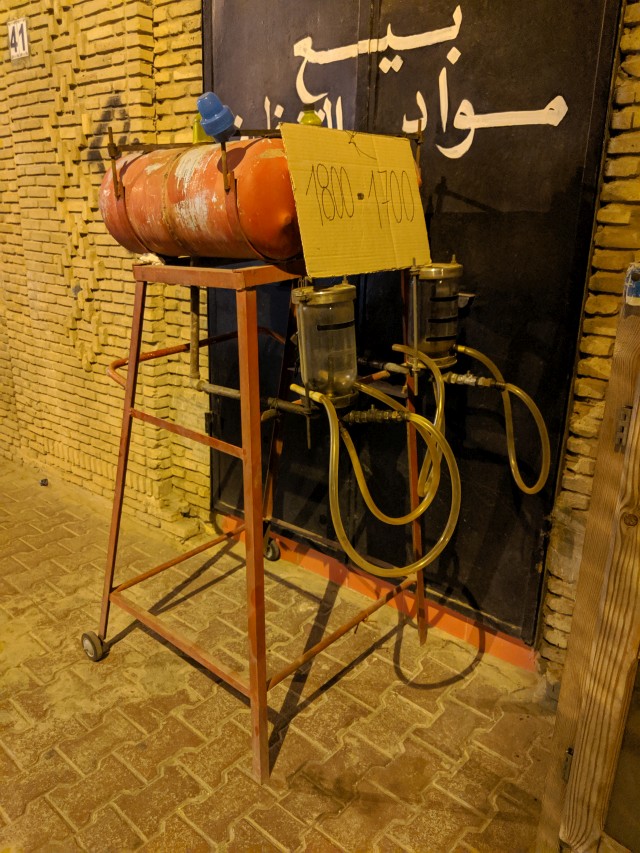
Endnote
I had a great time in Tunisia and would very much recommend it to anyone wanting an introduction to North Africa. Once you have the transportation figured out, i.e. use louages, the range of possibilities in country opens up quickly.
I’m sure there were plenty of things I didn’t get a chance to see, and foods that I didn’t get to try, but as a destination in mid-October to get away from the beginnings of a dreary European autumn, it was just the ticket.